Art Object Has a Specific Relationship With the Culture
Chris Burden's Metropolis II is an intense kinetic sculpture, modeled afterward a fa…
Perhaps the nigh dominant art form of the last 100 years, film has an important…
Tuesday Matinees
Enjoy concerts featuring leading international and local ensembles in programs o…
Art & Music,Jazz at LACMA,Latin Sounds,Sundays Live
Painting, printmaking, collage, and more than—all from the condolement of your own home!…
Random International's Rain Room (2012) is an immersive surround of perpetual…
Rain Room
Creative person Robert Irwin's work in the terminal five decades has investigated perception…
Barbara Kruger'southward Untitled (Shafted) features her distinctive use of advertizing…
Band (2006) may authorize as Richard Serra'due south magnum opus, representing the fullest…
LACMA'southward Modernistic Art collection, which primarily features European and American ar…
LACMA'south Acquisitions Group and Art Council members share a deep affinity for the…
Art Councils,Acquisition Groups,Art of the Middle East: CONTEMPORARY,Asian Fine art Council,Costume Council,Decorative Arts and Design Quango,LENS: Photography Council,Modernistic and Contemporary Art Council,Prints and Drawings Quango
Welcome to the employment page of the Los Angeles County Museum of Art. To see a…
Jobs,Careers,Internships,Volunteer
Bring together museum educators, artists, curators, and experts for artist talks, virtual…
Create+Collaborate
In Aureate Hour, over lxx artists and three photography collectives offer an aesth…
Established in 1967, the Conservation Heart at LACMA supports the museum'south comm…
painting conservation,newspaper conservation,object conservation,textile conservation,conservation scientific discipline,conservation imaging
Barbara Kruger: Thinking of You. I Hateful Me. I Mean You. is a major exhibition de…
Featuring Ai Weiwei, Huang Yong Ping, Wang Guangyi, Xu Bing, Yue Minjun and more than…
Beyond the concrete materials of ink and paper, at that place is an intangible spirit un…
To complement the presentation of The Obama Portraits by Kehinde Wiley and Amy South…
From the moment of their unveiling at the Smithsonian's National Portrait Galler…
(Los Angeles, CA—January 13, 2022) – The Los Angeles County Museum of Art (LACMA…
(Los Angeles, CA—December 14, 2021) The Los Angeles County Museum of Art (LACMA)…
Mixpantli: Contemporary Echoes showcases the lasting impact of Indigenous creati…
LACMA marks the 500th anniversary of the fall of the Aztec capital Tenochtitlan…
Since the mid-20th century, California has been a beacon of both inventive desig…
Revealing insights near family life and the quotidian in the 21st century, Fami…
I of the most pregnant contributors to fashion between 1990 and 2010, Lee A…
Comprising approximately 400 works, including an unprecedented number of loans f…
Archive of the World: Art and Imagination in Castilian America, 1500–1800 is the f…
Scandinavian Pattern and the United States, 1890–1980 is the first exhibition to…
In the work of American creative person Sam Francis (1923–1994), Western and Eastern aest…
New galleries. More than art. For all of Los Angeles.
A new way to come across the world'due south cultures—past, present, and future.
Over the last two decades, LACMA has sought to find new means to embrace all the communities of Los Angeles County and honor all the world's artistic traditions. Our goal is to make the experience of our collection richer and more accessible than e'er earlier, while ensuring that the museum can be a place of reflection, expression, and empathy for everyone.
These years of evolution and expansion are culminating with the improver of the David Geffen Galleries, a magnificent new building for the permanent drove designed by Pritzker Prize-winning architect Peter Zumthor. With over $670 one thousand thousand raised out of a $750 million goal, and construction well underway, we are in the final stages of bringing this next evolution of LACMA to all of Los Angeles.
Leading up to the construction of the David Geffen Galleries, the museum added ii buildings, the Wide Contemporary Art Museum (2008) and the Resnick Exhibition Pavilion (2010), designed by another Pritzker Prize winner, Renzo Piano; enhanced outdoor programming with the installation of Urban Calorie-free (2008) and Levitated Mass (2012); and opened Ray's and Stark Bar on our Smidt Welcome Plaza. We have also recently completed a thorough renovation of a third edifice, the Pavilion for Japanese Art.
LACMA belongs to the people of Los Angeles Canton—this plan represents a fresh, Los Angeles take on a big art museum, one that is rooted in our delivery to openness, accessibility, and equity.
Nosotros invite you lot to exist a role of the new LACMA.
-
Edifice LACMA Film Series
Message from the Managing director
Entrada Donors
Most the Architect
LACMA'south History
Building Facts
Construction Updates
Learn More at BuildingLACMA.org
Renderings
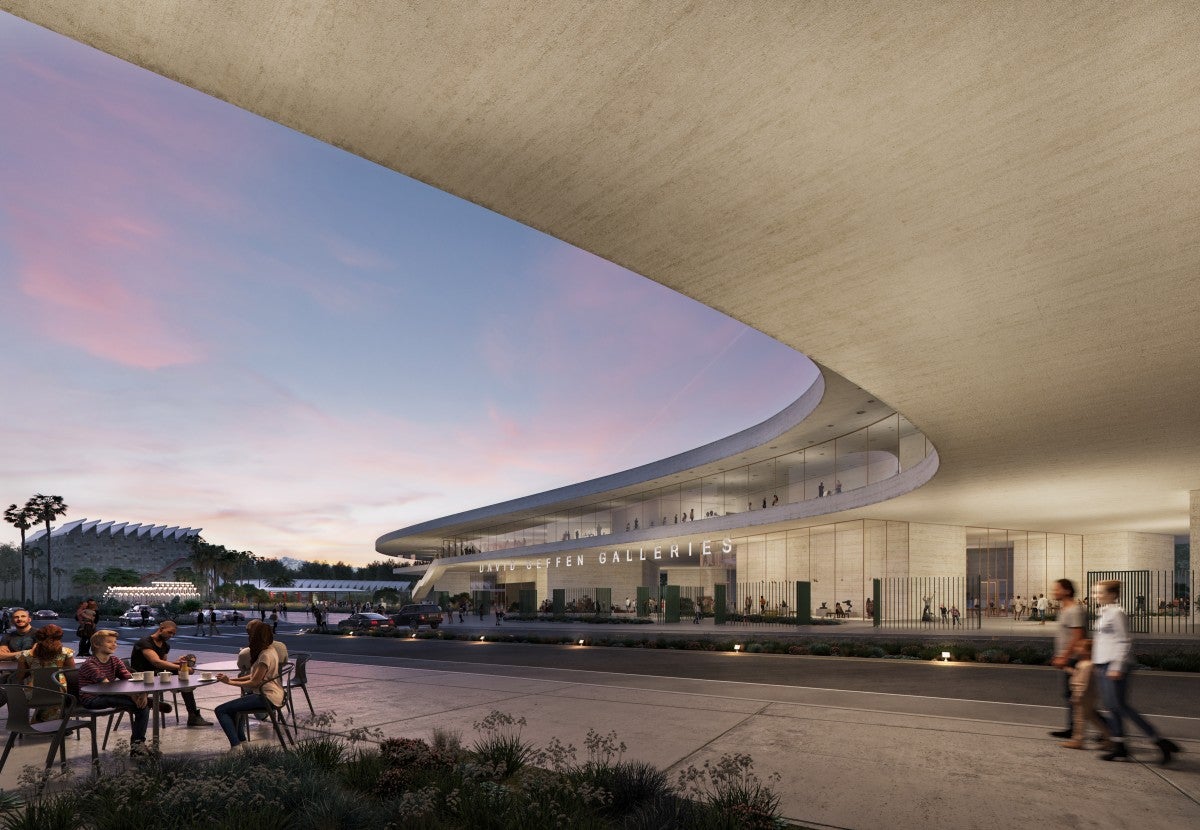
View northwest toward BCAM, Resnick Pavilion, Smidt Welcome Plaza, and Urban Light, Atelier Peter Zumthor/The Boundary
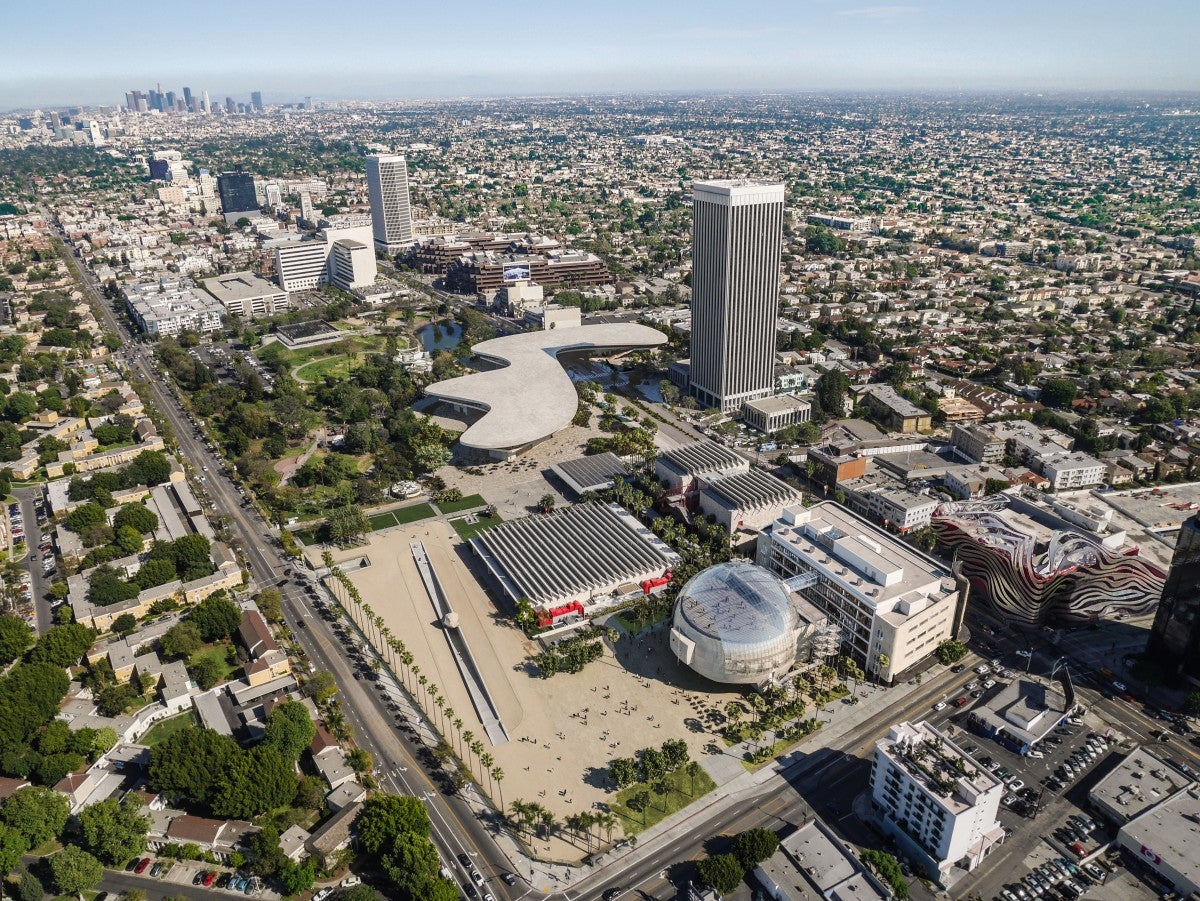
Aerial view of LACMA's campus, including David Geffen Galleries, in context of Museum Mile, Atelier Peter Zumthor/The Boundary
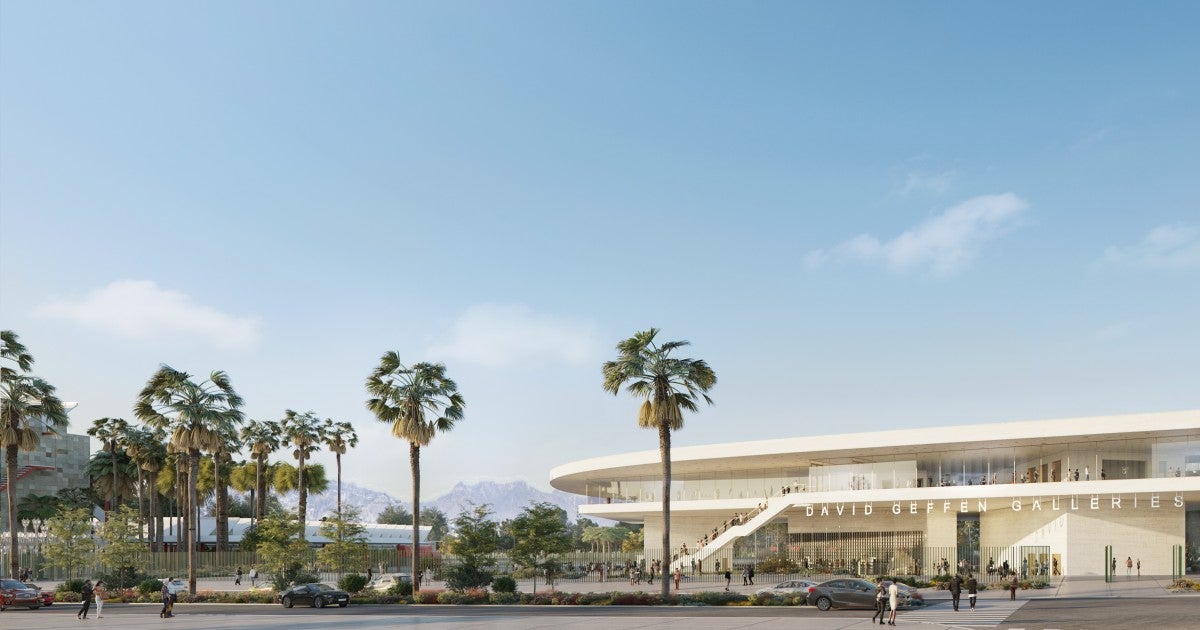
View north across Wilshire Boulevard, Atelier Peter Zumthor/The Boundary
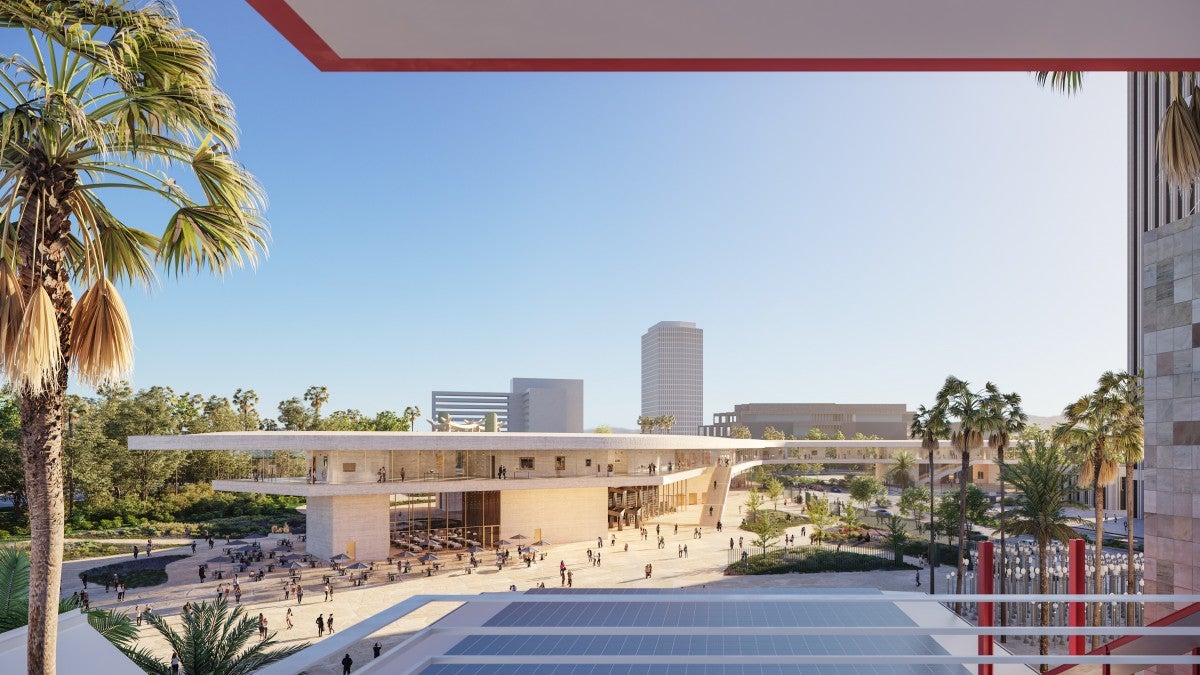
Exterior view east from BCAM, Atelier Peter Zumthor/The Purlieus
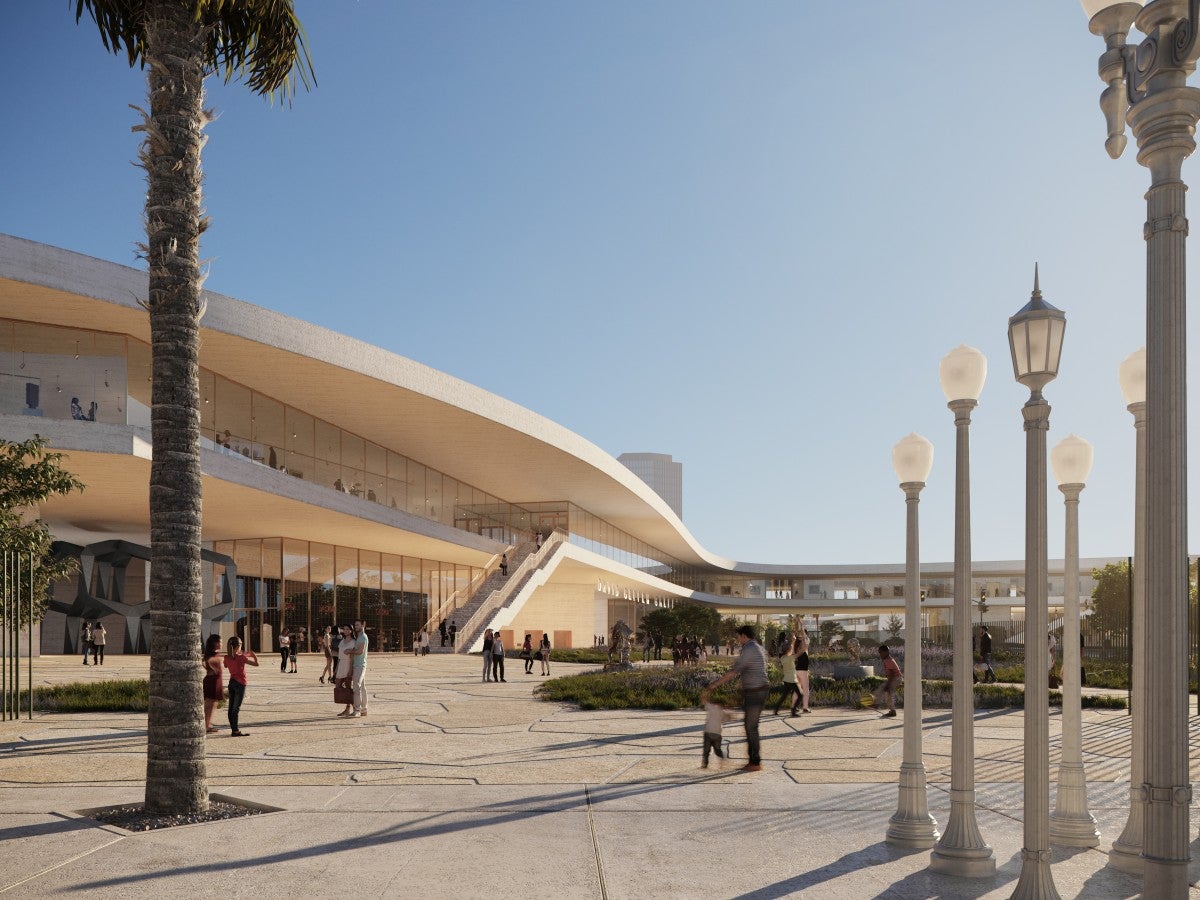
View of north archway stairs from Urban Light, Atelier Peter Zumthor/The Purlieus
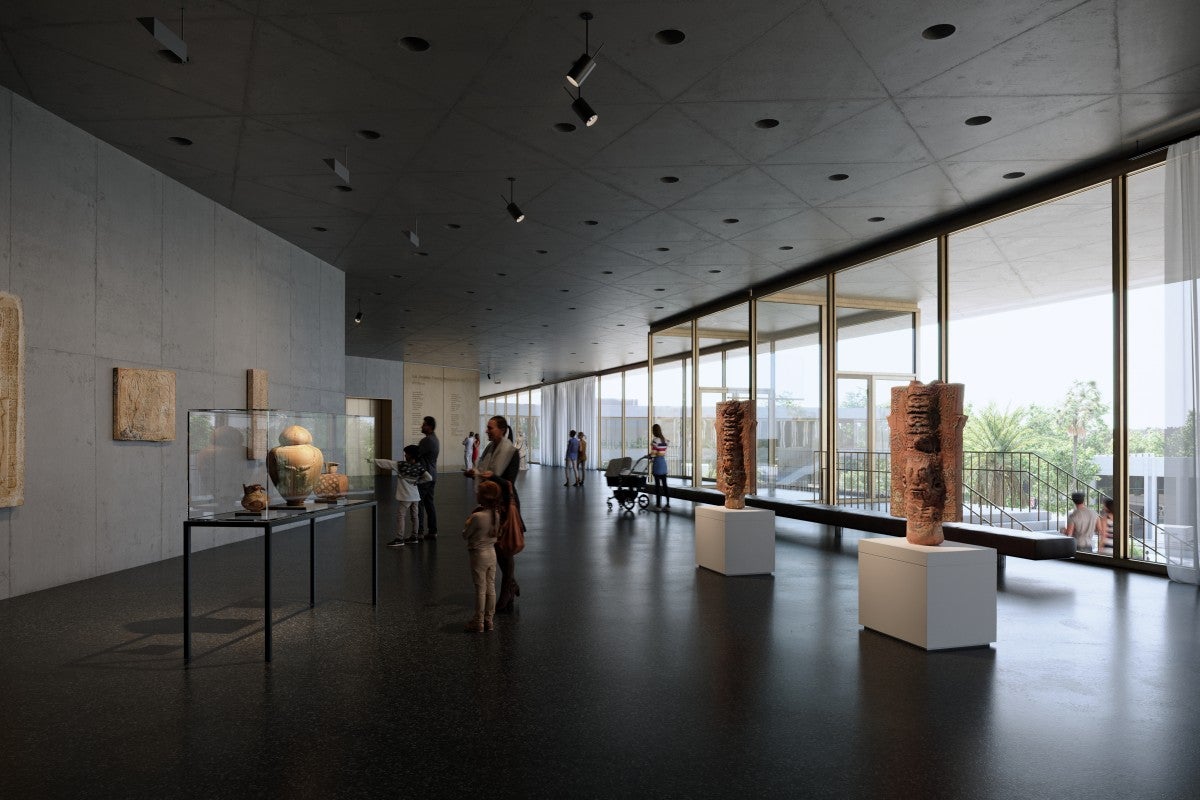
Terrace and due north entrance galleries, exhibition level, Atelier Peter Zumthor/The Boundary
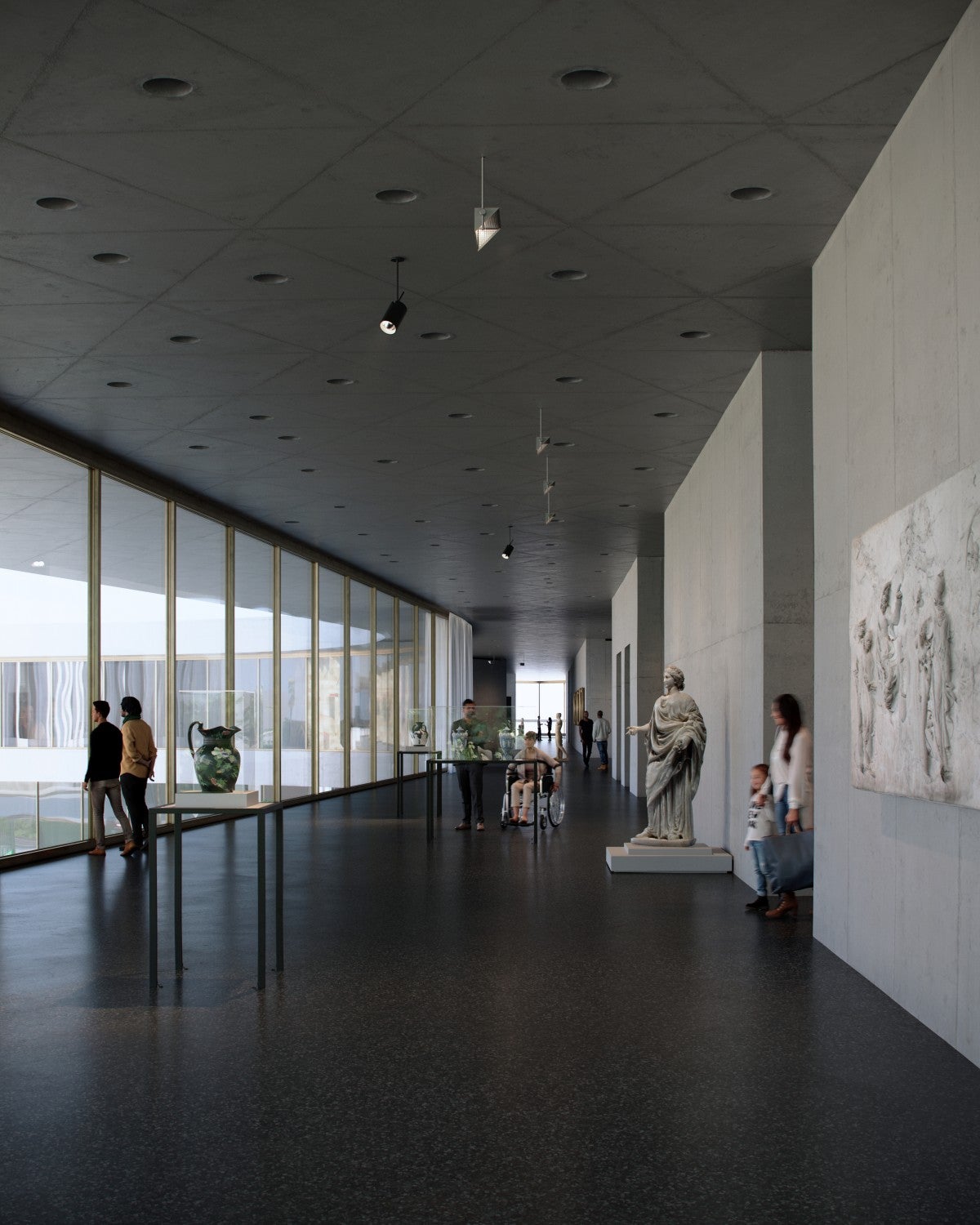
Terrace and south entrance galleries facing northward, exhibition level; Atelier Peter Zumthor/The Boundary
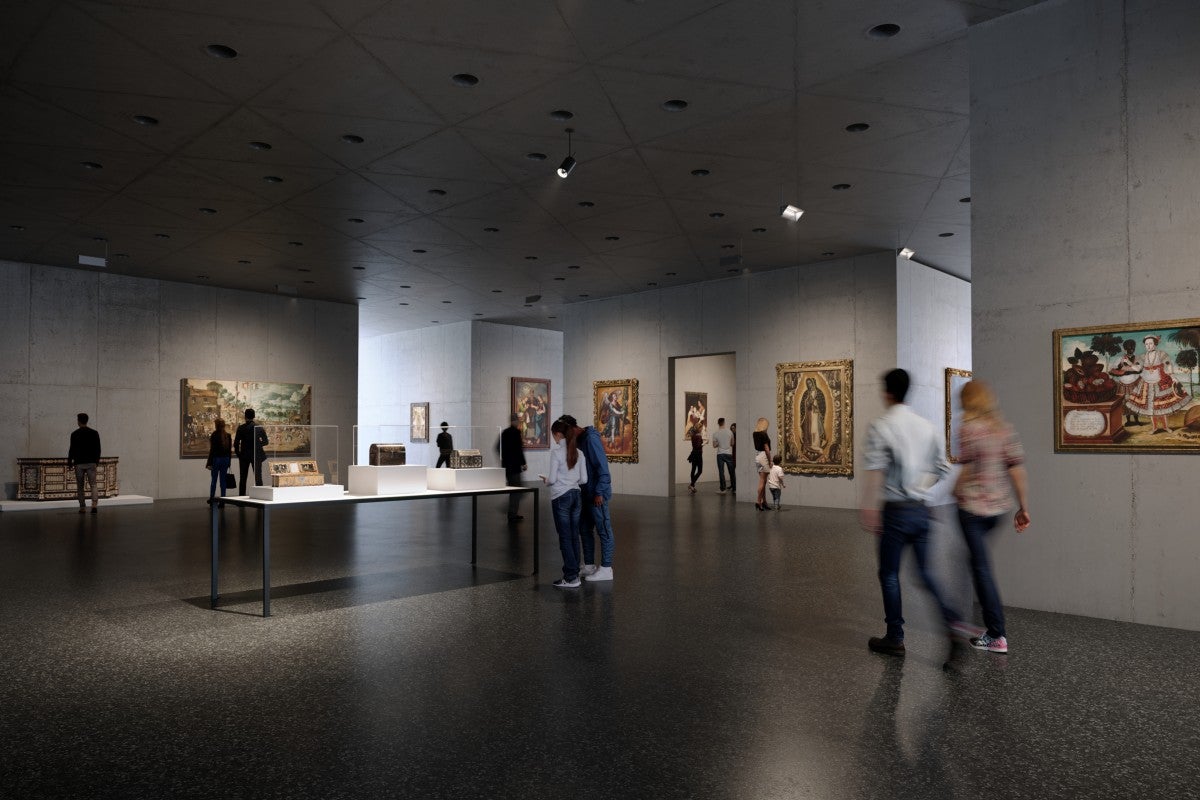
Courtyard gallery, exhibition level, Atelier Peter Zumthor/The Purlieus
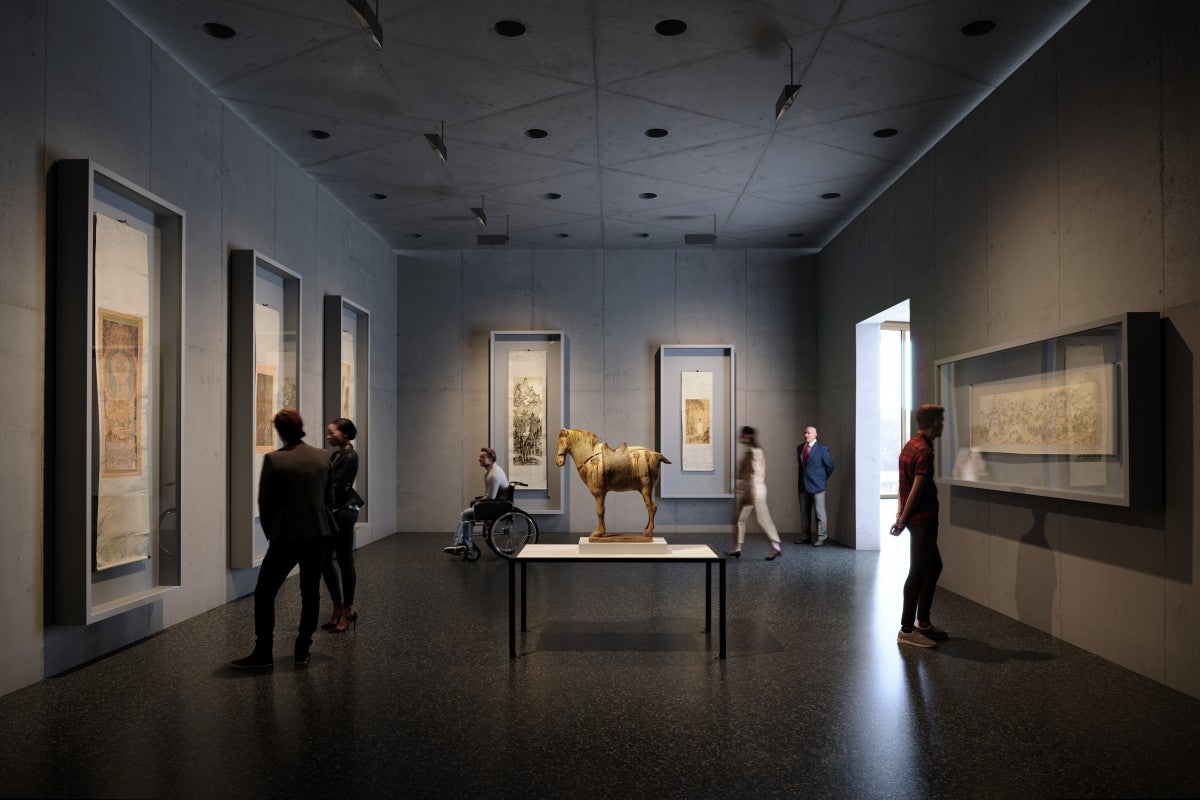
Interior gallery, exhibition level, Atelier Peter Zumthor/The Purlieus
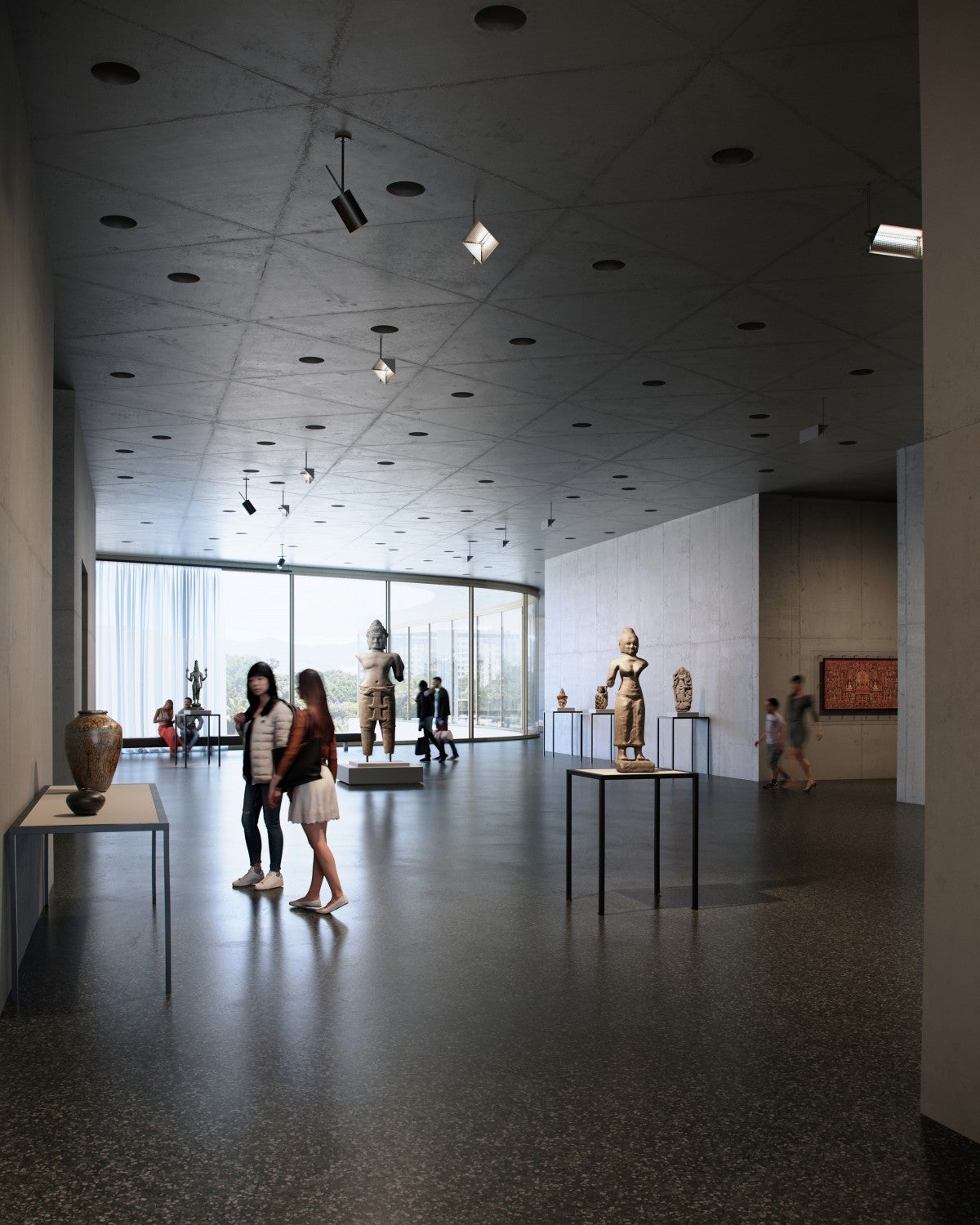
Courtyard gallery, exhibition level, Atelier Peter Zumthor/The Boundary

Interior gallery, exhibition level, Atelier Peter Zumthor/The Boundary
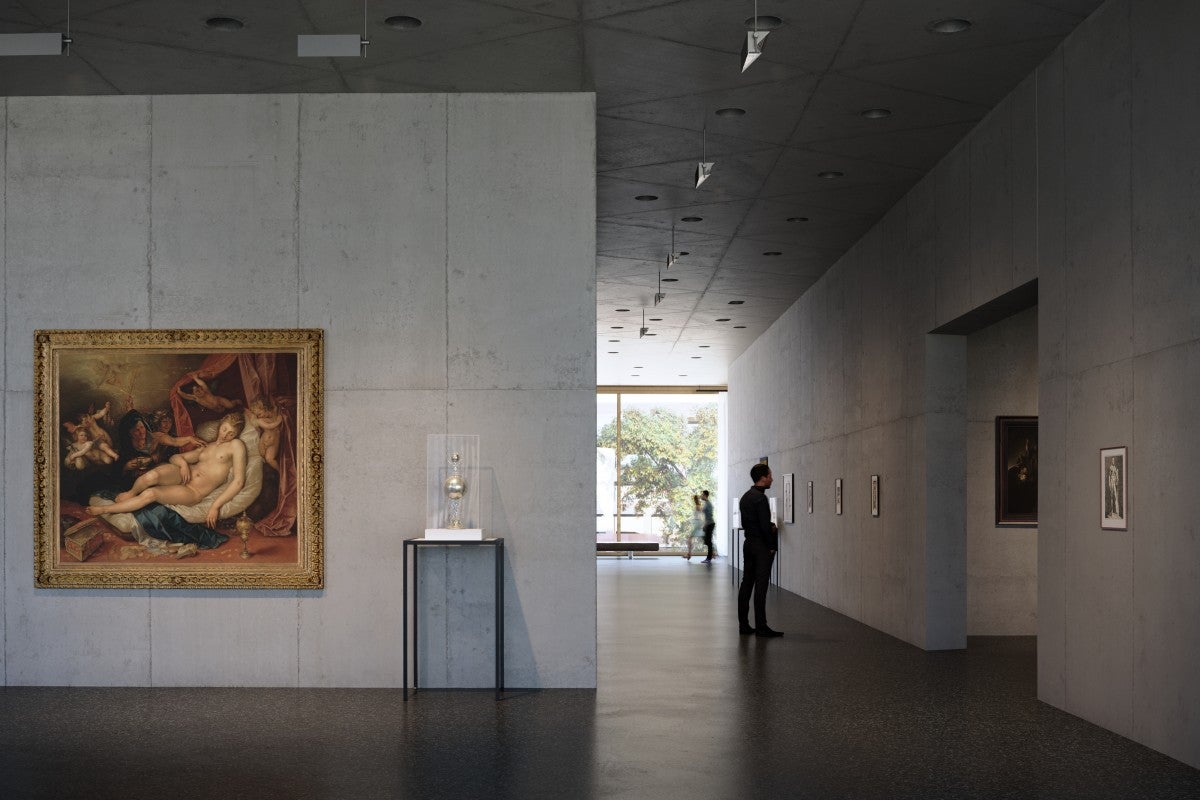
Courtyard gallery, exhibition level, Atelier Peter Zumthor/The Boundary
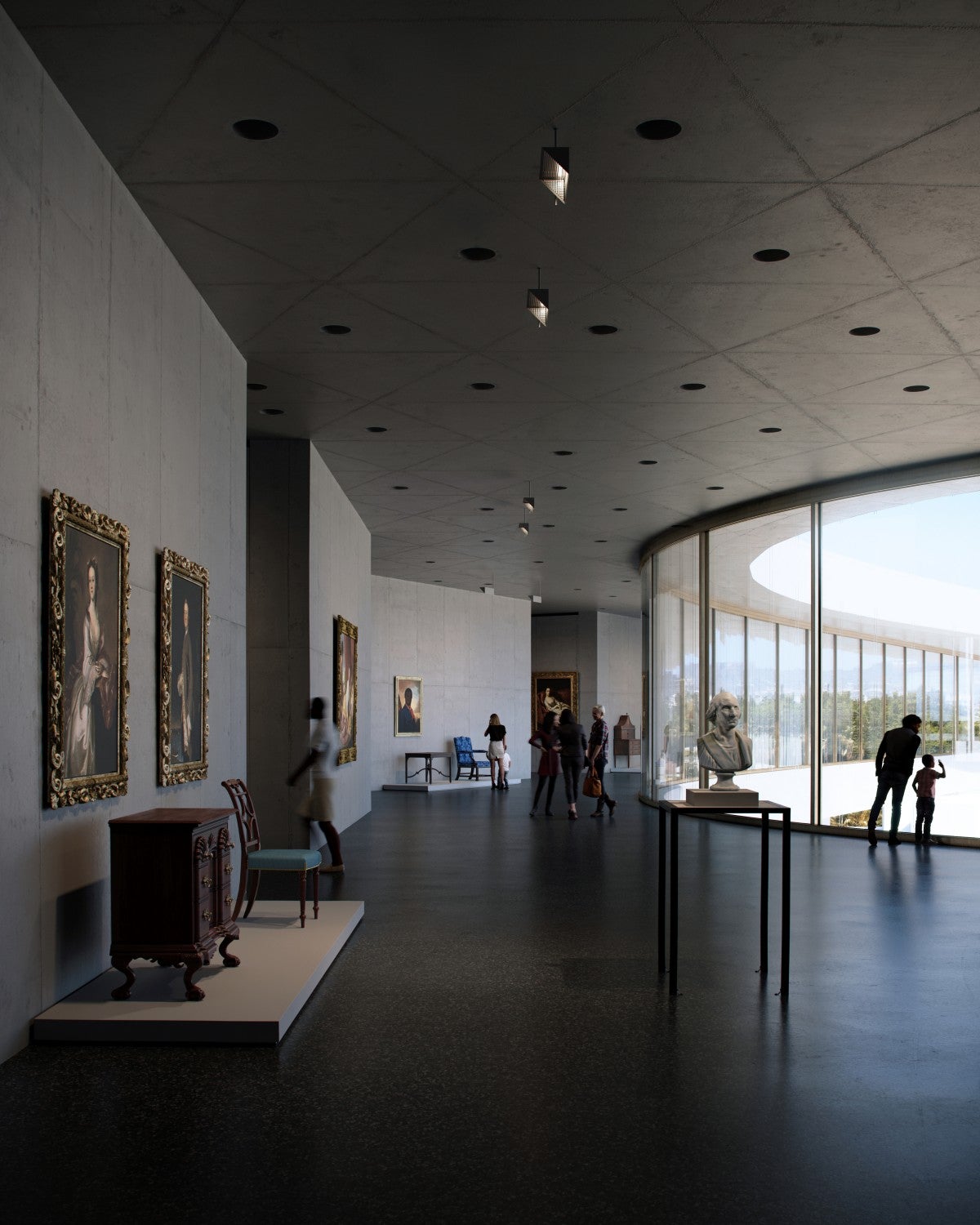
Terrace galleries, exhibition level, Atelier Peter Zumthor/The Boundary
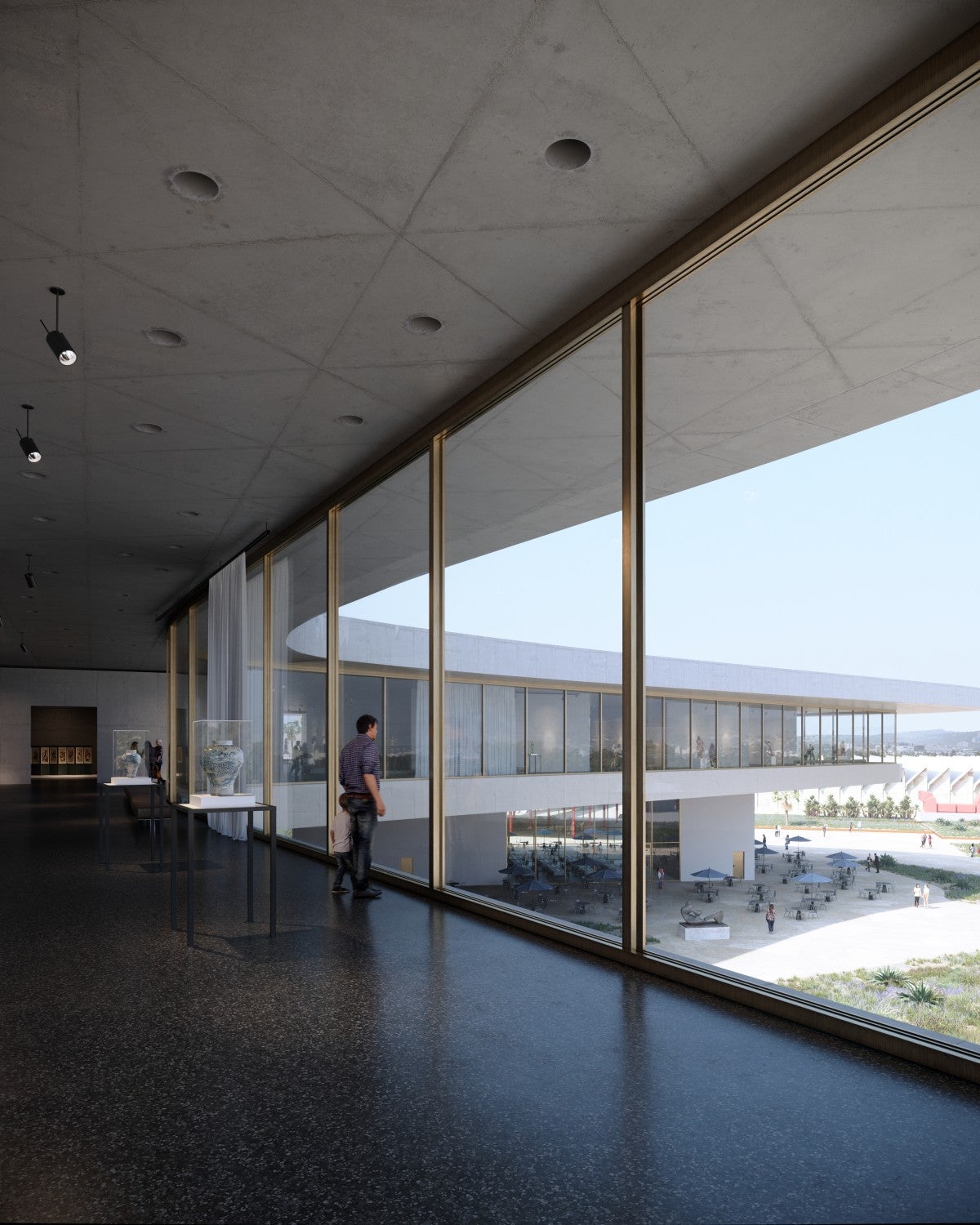
Terrace galleries facing due west towards Resnick Pavilion, exhibition level, Atelier Peter Zumthor/The Boundary
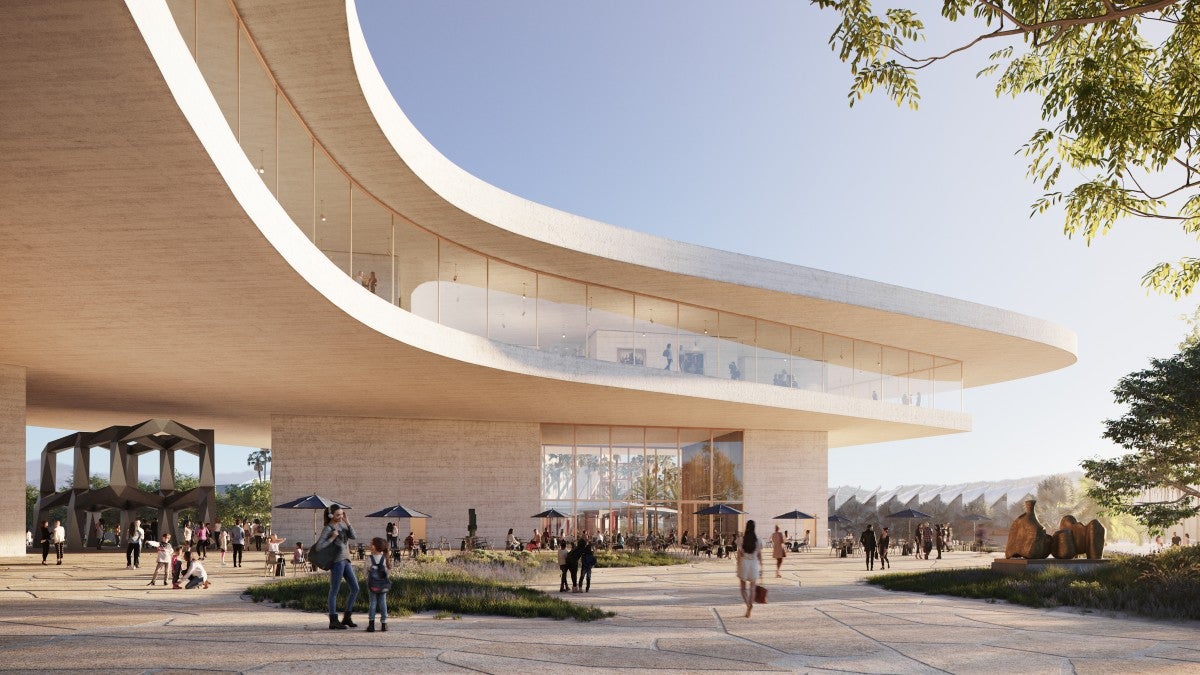
Exterior view due west toward the Resnick Pavilion, Atelier Peter Zumthor/The Boundary
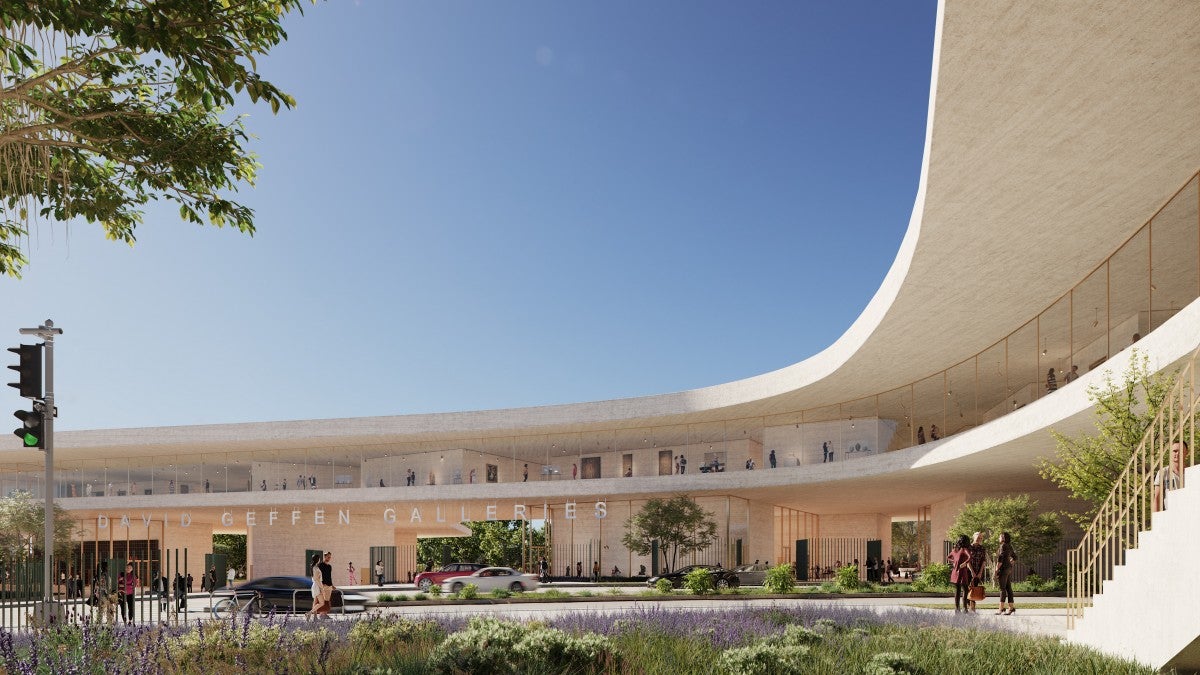
View north across Wilshire Boulevard, Atelier Peter Zumthor/The Purlieus
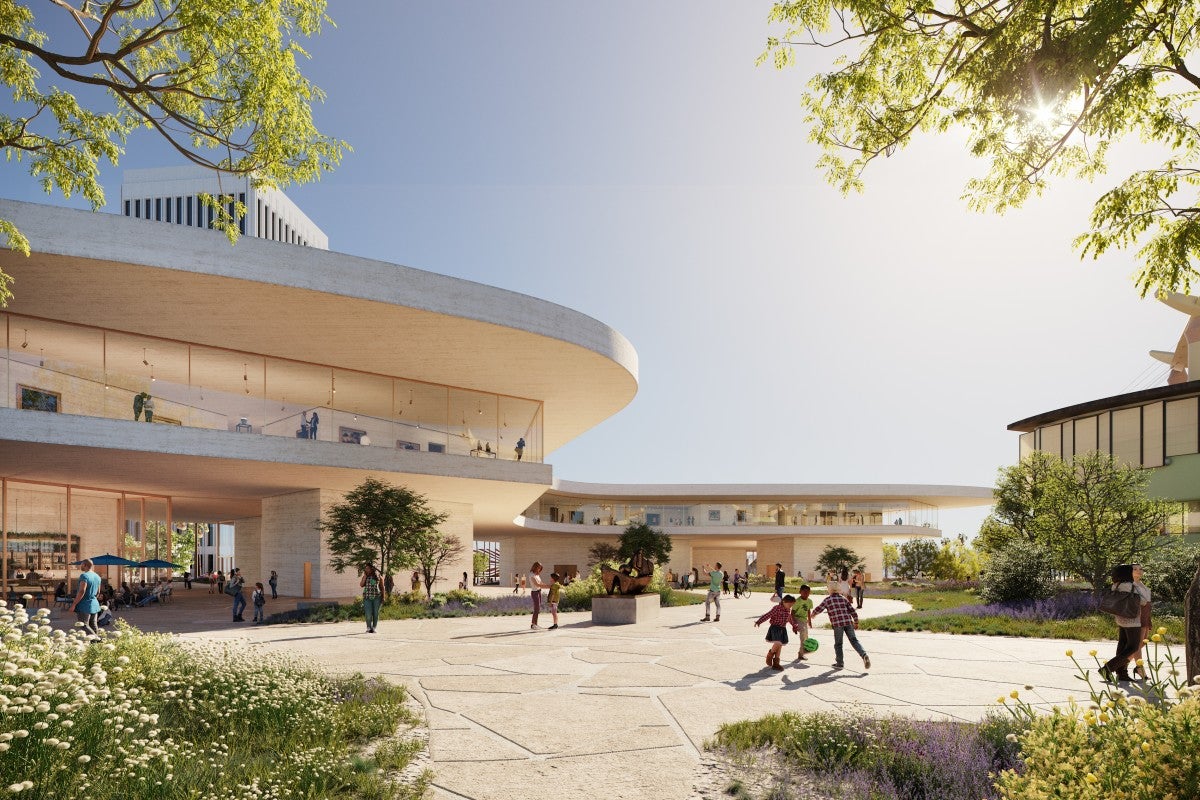
Exterior view southwest from Hancock Park, Pavilion for Japanese Art on the far correct, Atelier Peter Zumthor/The Purlieus
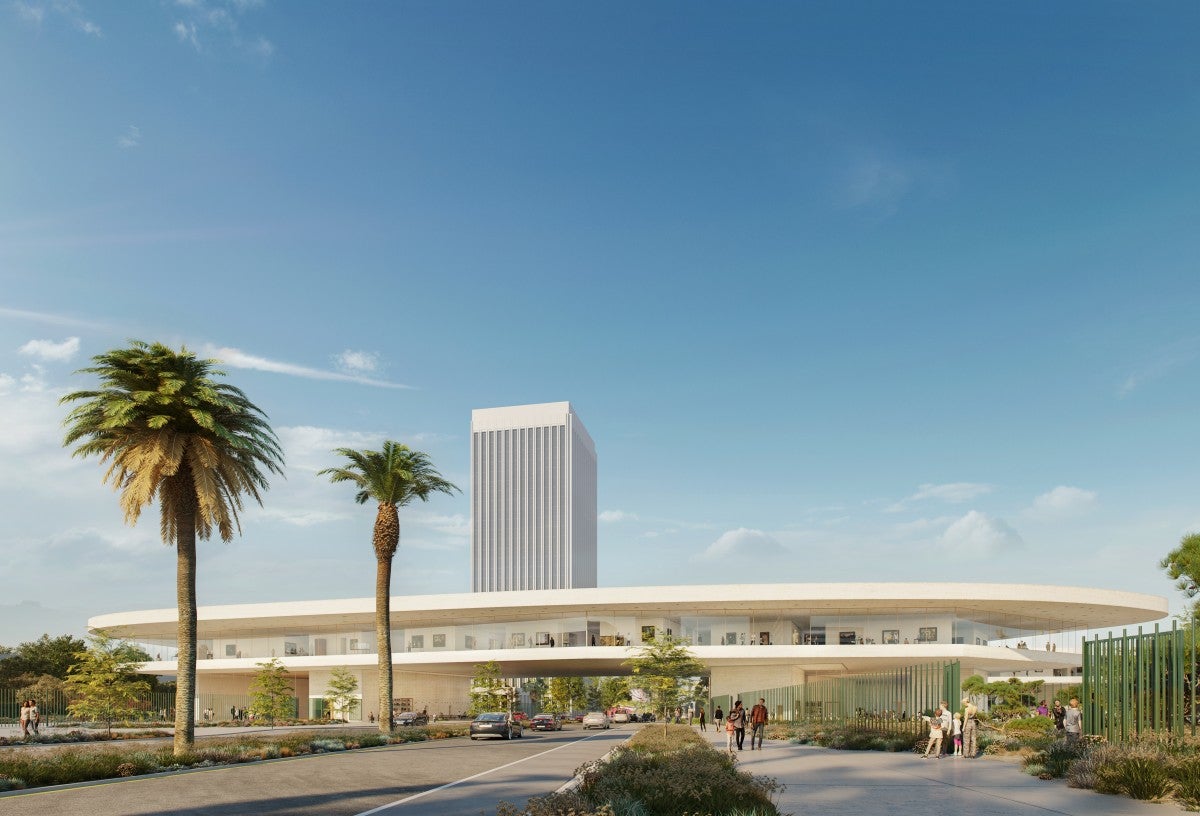
View west downward Wilshire Boulevard, Atelier Peter Zumthor/The Purlieus

View west downwards Wilshire Boulevard, Atelier Peter Zumthor/The Boundary
How volition areas of LACMA'south collection come to life as never before in the new David Geffen Galleries at LACMA? Find out in a series of short videos virtually the new building coming to our campus.
The history of art is long, merely the history of museums is brusk. The art museum as we know information technology has existed for less than three hundred years, a cabinet of far-flung curiosities first created for societies not even so familiar with the airplane, the television, or the internet. And then much has inverse in the world; the art museum must evolve also.
Peter Zumthor's plan for the new edifice to house LACMA's galleries offers an culling to the traditional museum model. His design is grounded in his delivery to creating "emotional infinite," which mirrors LACMA's own mission to cultivate meaningful connections between fine art and the people appreciating it.
Glass walls invite museum visitors to await out at the landscape and light of Los Angeles, and permit passersby to see in. This translucent outside visually connects the galleries to everyday life on Wilshire Boulevard and in the surrounding park, and offers spectacular views of the city and mountains beyond. Zumthor'due south design also adds ample new public outdoor space to create an even more accessible cultural and social hub for the community.
The horizontality of the new edifice is both a reflection of Los Angeles and a cadre concept within LACMA's vision for presenting the permanent collection. It positions art from all areas of the museum's diverse collections on the same plane, to better adapt the shift in LACMA'due south curatorial strategy from fixed presentations to rotating exhibitions of the permanent drove. The edifice is designed to mirror the diverseness of our vast city and, through design and spirit, to accelerate LACMA'due south mission to serve the public by encouraging profound cultural experiences for the widest array of audiences.
In order to build on the success and legacy of LACMA's more 50 years, the museum must lay a strong foundation for the future now. With extraordinary back up from the County of Los Angeles and the lath of trustees, as well as leadership gifts from David Geffen—whose historic souvenir is recognized in the edifice's name, the David Geffen Galleries—and a number of other donors, fundraising for the project has been extremely successful and but continues to exceed expectations.
This success means the museum stands poised to complete the next step in its transformation, creating a landmark that will identify LACMA for its next l years and beyond.

Michael Govan
CEO and Wallis Annenberg Managing director
To those whose immense generosity to the Building LACMA and Transformation campaigns is recognized below, thank you. Together, yous take contributed over $1 billion since 2004 toward creating a futurity for LACMA for all of Los Angeles to enjoy.
Entrada Donors, $one Million and Above
| $100,000,000 and above Canton of Los Angeles | $l,000,000 and in a higher place Eli and Edythe L. Wide Foundation |
| $20,000,000 and above Annenberg Foundation | $10,000,000 and to a higher place Debbie and Mark Attanasio And those who wish to remain anonymous |
| $5,000,000 and above The Honorable Frank Eastward. Baxter and Kathrine Baxter And those who wish to remain anonymous | $two,500,000 and in a higher place The Ahmanson Foundation |
| $1,000,000 and to a higher place The Honorable Nicole Avant and Ted Sarandos | Robert and Mary M. Looker And those who wish to remain bearding |
An exciting attribute of LACMA's new building is that information technology is Peter Zumthor'due south first project in the United States. Ane of the world'southward most respected architects, Zumthor is known for projects including the Therme Vals, Switzerland (1996); the Kunsthaus Bregenz, Austria (1997); Kolumba Art Museum, Cologne (2007); and the Serpentine Gallery Pavilion, London (2011).
A hallmark of Zumthor's work is that no two buildings are the same; it is often noted that he has no single style. Several characteristics, withal, are mutual to each project. Starting time is the attending to the site, and another is the utilize of specific materials—wood, concrete, brick, or rock. Nearly prized of all is Zumthor's good choreography of light and shadow in each of his buildings.
Zumthor was trained as a cabinetmaker in his male parent's shop in his native Basel, Switzerland, and subsequently attended Basel's Kunstgewerbeschule (Craft School) and Pratt Establish in New York City, where he studied industrial pattern and architecture. He began his career equally a conservation architect for the Department for the Preservation of Monuments in the Swiss canton of Graubünden, an experience that deepened his noesis of a broad range of construction methods and materials. He established his ain architectural firm in 1978 in Haldenstein, Switzerland.
Before he began his work for LACMA in 2009, Zumthor taught in Los Angeles equally a visiting professor at the University of Southern California and SCI-ARC. He has received international awards including the Praemium Imperiale, the Imperial Gold Medal of the Royal Found of British Architects, and the Pritzker Compages Prize—the most prestigious recognition in the field—for his distinguished torso of work
With structure of the David Geffen Galleries well underway, nosotros accept surpassed the midway betoken of LACMA's current transformation. The history below details how LACMA'south campus has been imagined, congenital, and rebuilt since earlier it opened on Wilshire Boulevard in 1965.
An Art Drove Begins
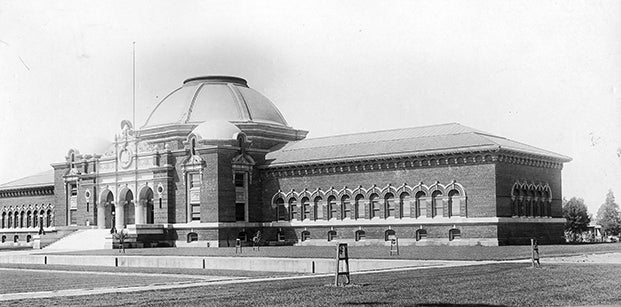
Frank Dale Hudson and William A. O. Munsell, architects
The Los Angeles County Museum of History, Science, and Fine art in Exposition Park was completed in 1913 in the French beaux-arts style allegorical of high culture in the early twentieth century. In the late 1950s, museum and other civic leaders—in response to the rapidly expanding collection and the conviction that a hallmark of a major city was an independent art museum—initiated a motility to establish a dedicated building for art. The Canton Museum was divided into two divide institutions in 1961, with what is now the Natural History Museum of Los Angeles County remaining in the original location.
Choosing a Site and an Architect
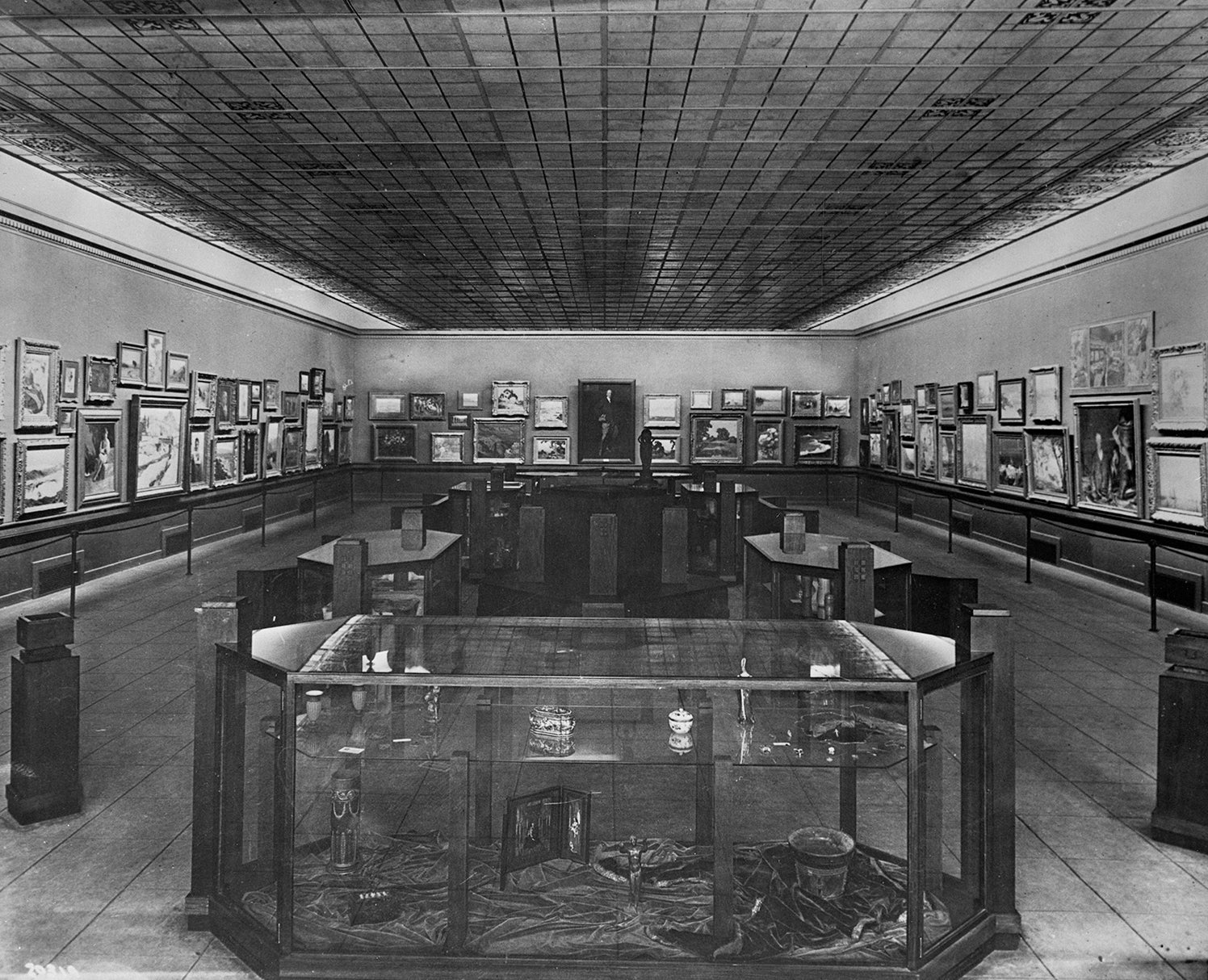
Natural History Museum of Los Angeles County Museum Archives
The site chosen for the new art museum was the La Brea Tar Pits in Hancock Park. One of the world'south richest and nearly renowned sources of late Ice Age fossils, information technology had become a public park in 1924. After the canton approved a split up building for an fine art museum, an intensive search for the right architect began. LACMA'south ambitious and adventurous principal curator of art, Richard "Ric" Dark-brown, who would become director in 1961, was a passionate advocate of Ludwig Mies van der Rohe. While Brown asserted that Mies was "considered to be the greatest living architect," he presented other choices to the board, whose members had their own preferences. Local architect William Fifty. Pereira was a compromise candidate and his firm was given the commission in March 1960. As Edward Carter, the board chair, told the Los Angeles Times in a 1979 interview: "We all decided Pereira would be a satisfactory 2d choice."
The William L. Pereira Buildings
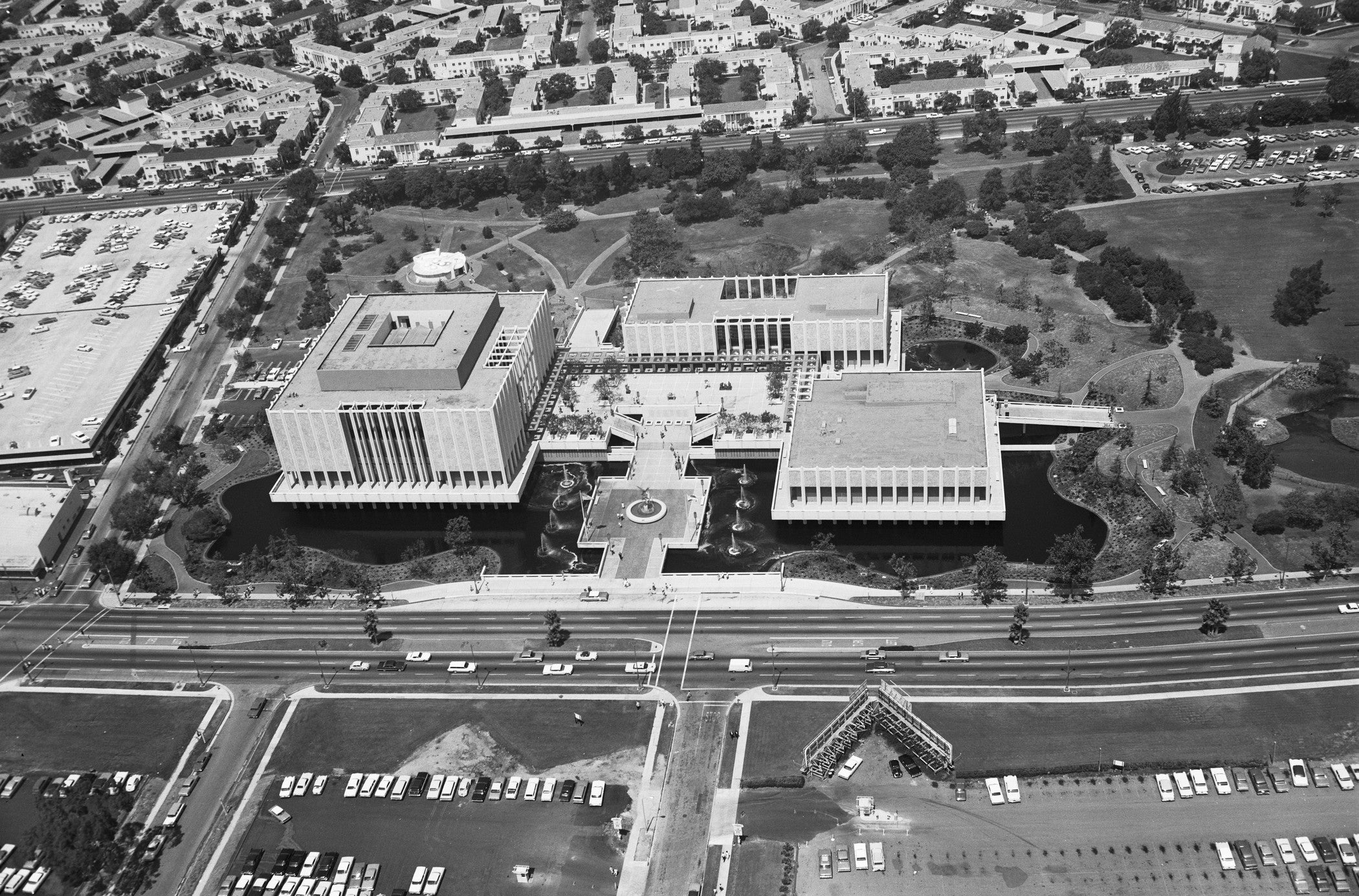
William Fifty. Pereira, builder; Thomas Dolliver Church, landscape builder; Robert Herrick Carter, landscape builder
The Los Angeles Canton Museum of Art opened in March 1965, amongst an outpouring of civic pride and a spectacle of fireworks. Designed in a modern classicist style, the new museum consisted of iii pavilions: the Ahmanson Gallery of Fine art, which housed the permanent collections; the Lytton Gallery, for temporary exhibitions; and the Leo S. Bing Centre, which included the theater, library, and education spaces.
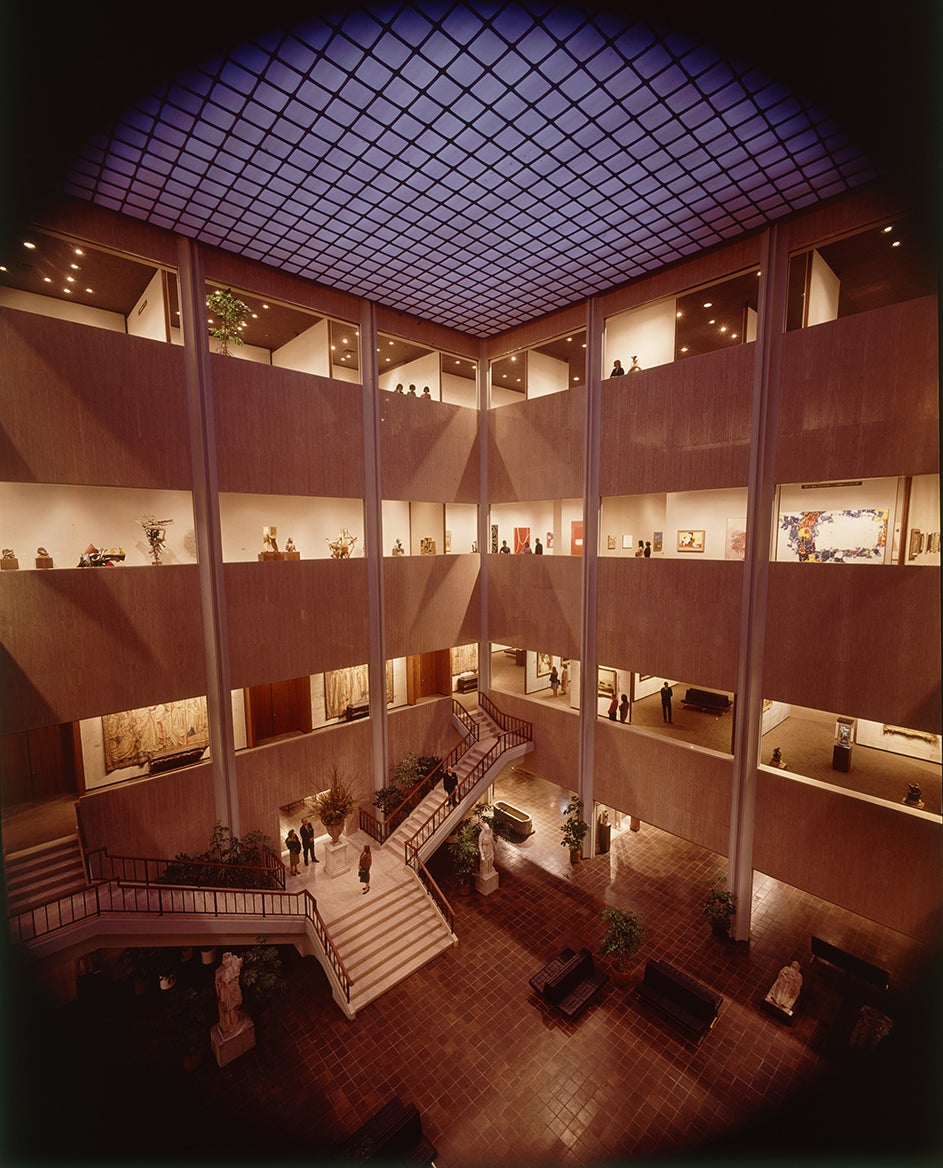
William L. Pereira, architect; photo: Ralph Crane/The LIFE Picture Drove/Getty Images
Many admired the new art acropolis and how it appeared to float over the biomorphic pools and fountains. While the Los Angeles Times heralded information technology equally a "noble contribution to the world of art," assessments of the buildings were always mixed. The decision to have multiple structures had been political—the board adhered to the wishes of the largest donors. This created immediate circulation issues and, near from the very beginning, the galleries were considered to be confusingly laid out and too pocket-sized. The reflecting pools were primal to Pereira's programme and their well-nigh immediate failure greatly compromised his intent. His business firm had taken some measures to mitigate seepage from Hancock Park's viscous soil, but the board of trustees noted the "highly inflammable gas" in the e puddle and the need to constantly drain all the water features only 18 months after opening. The seepage of black tar remained a serious issue; inside 10 years, the pools were drained and replaced with a sculpture garden.
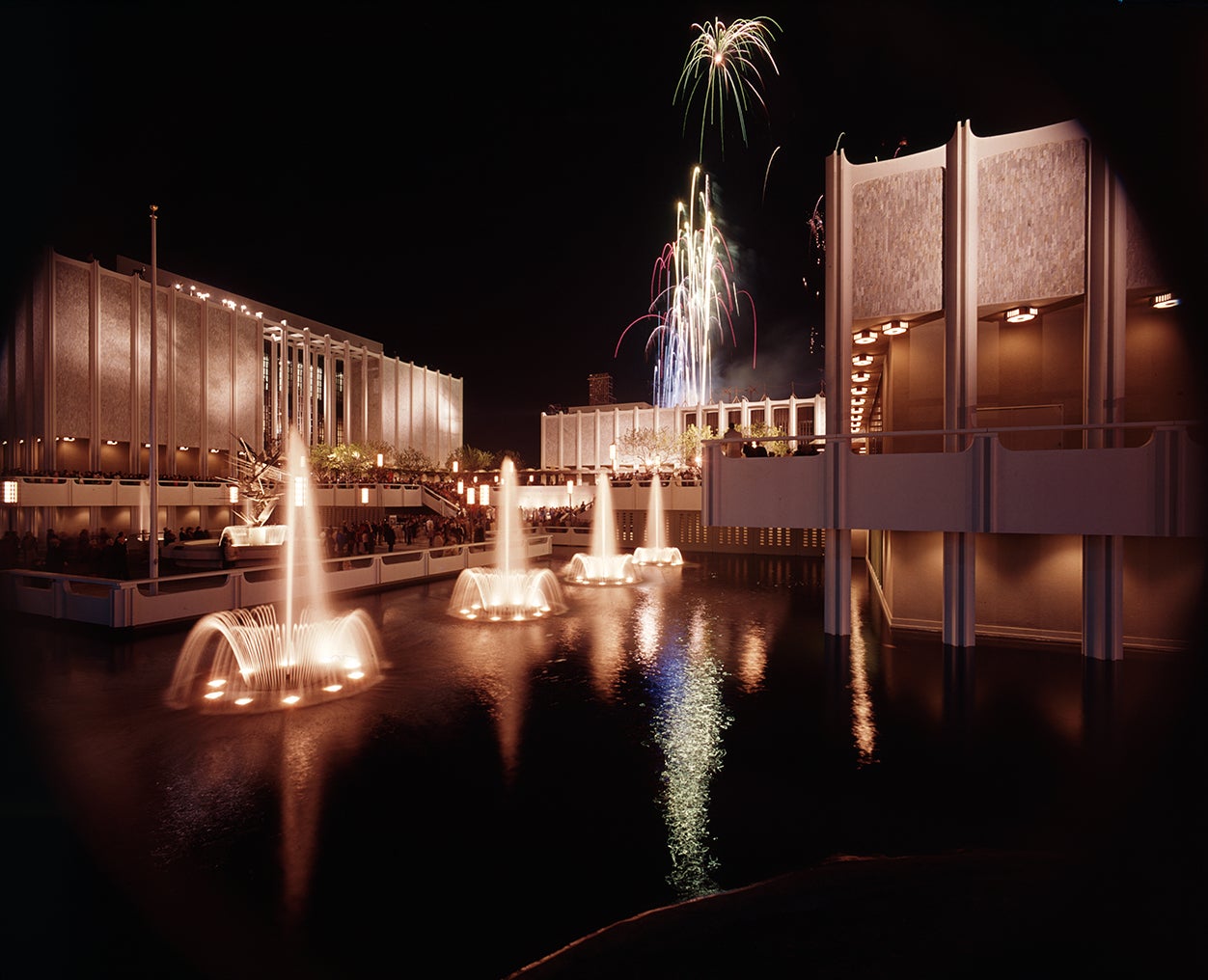
William 50. Pereira, builder; photo: Ralph Crane/The LIFE Motion-picture show Collection/Getty Images
At the core of the Ahmanson Gallery was a skylighted atrium intended to display large works of art and provide a space for parties and of import events. The museum'due south second director, Kenneth Donahue, spoke for many who objected that this expansive hall had attained its size at the expense of the surrounding galleries. In lodge to cut costs, the galleries had been made narrower than originally planned. Critics complained that these spaces, which disregarded the atrium from a border of balconies, were too shallow and hard to navigate. Over fourth dimension, the open walls were filled in with large panels, which increased the space available for displaying fine art but dramatically altered the original building design. Present-mean solar day building code requirements prevented the restoration of the original intent for the spaces.
An Improver by Hardy Holzman Pfeiffer
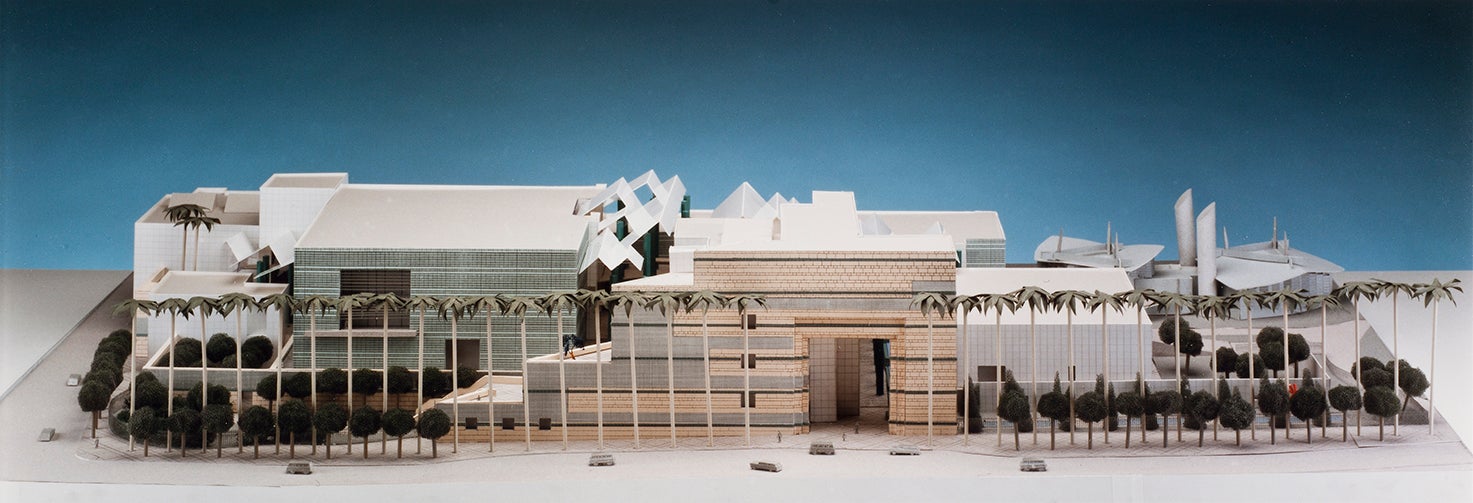
Hugh Hardy; Malcolm Holzman and Norman Pfeiffer, Hardy Holzman Pfeiffer Associates
Past the 1980s the collection had drastically outgrown its footprint, and LACMA's manager, Earl A. "Rusty" Powell III, led an effort to expand the institution. Both the managing director and the trustees conspicuously recognized the demand for a building dedicated to 20th-century art. The Robert O. Anderson Edifice (completed in 1986 and renamed the Art of the Americas Building) was designed by the New York firm Hardy Holzman Pfeiffer Assembly. In an effort to resolve the frustrating circulation patterns that had plagued the original design, the architects joined the existing buildings with a primal courtyard and reoriented the museum toward Wilshire Boulevard with an oversize facade referencing the art moderne fashion of classic Hollywood.
Hardy Holzman Pfeiffer had other plans to unify the campus. They proposed recladding the original 1965 buildings with green terracotta tile and porcelain panels to friction match the new construction as well as joining the buildings with pedestrian walkways at all corresponding levels. Part of this master programme was enacted, but Powell's departure in 1992 ensured that it would never be completed. And although the galleries, laid out in a traditional beaux-arts enfilade, were praised, the new building was seen as contributing to the aesthetic discord. The critic Robert Hughes'southward annotate that the Anderson Building "obliterated the old museum similar the behemothic foot in Monty Python" was typical.
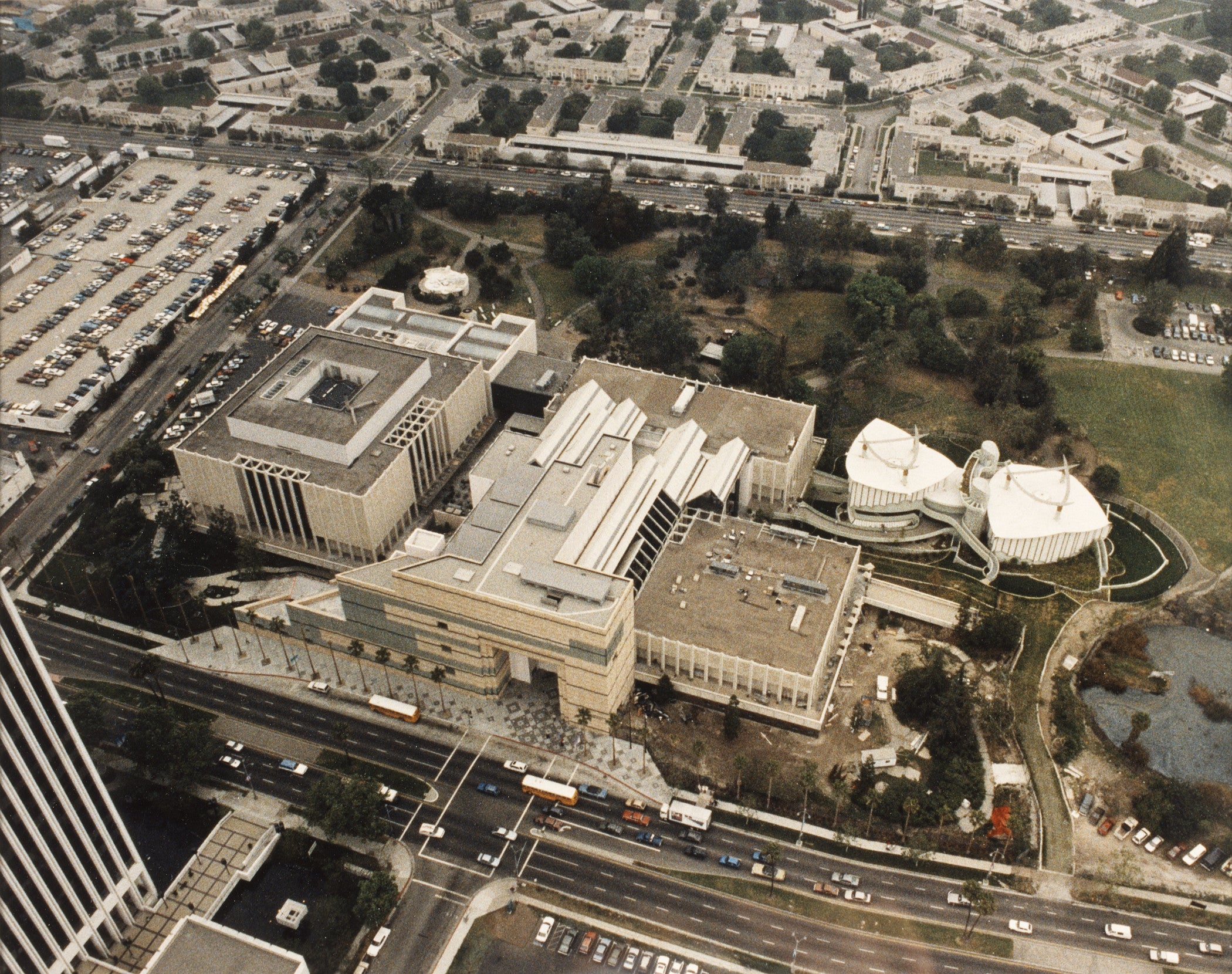
Bruce Goff's Pavilion

Bruce Goff with Bart Prince, architects
A disciple of Frank Lloyd Wright and an abet of organic architecture, the Oklahoma-based architect Bruce Goff was known for working closely with his patrons. While Joe Cost was the original commissioner of the Pavilion for Japanese Art (completed in 1988), he alleged, "Nosotros . . . designated a new type of client—the art itself." Designed to firm Price'southward globe-form drove of Edo catamenia roll and screen paintings, the gallery infinite evoked the fashion the works would have been displayed in traditional Japanese homes. A multistory spiral ramp led visitors on a defined path through the gallery, punctuated by horizontal viewing platforms. Instead of grouping paintings on walls, Goff created alcoves reminiscent of traditional Japanese tokonoma that promote intimate encounters with each artwork. The suspended roof enabled the paneled walls to be made of Kalwall, a translucent plastic meant, equally Goff's architectural collaborator Bart Prince explained, "to allow the natural light to filter through in a like fashion as shoji screens" and also provided a more than integrated relationship to the surrounding park.
Rem Koolhaas's Proposal
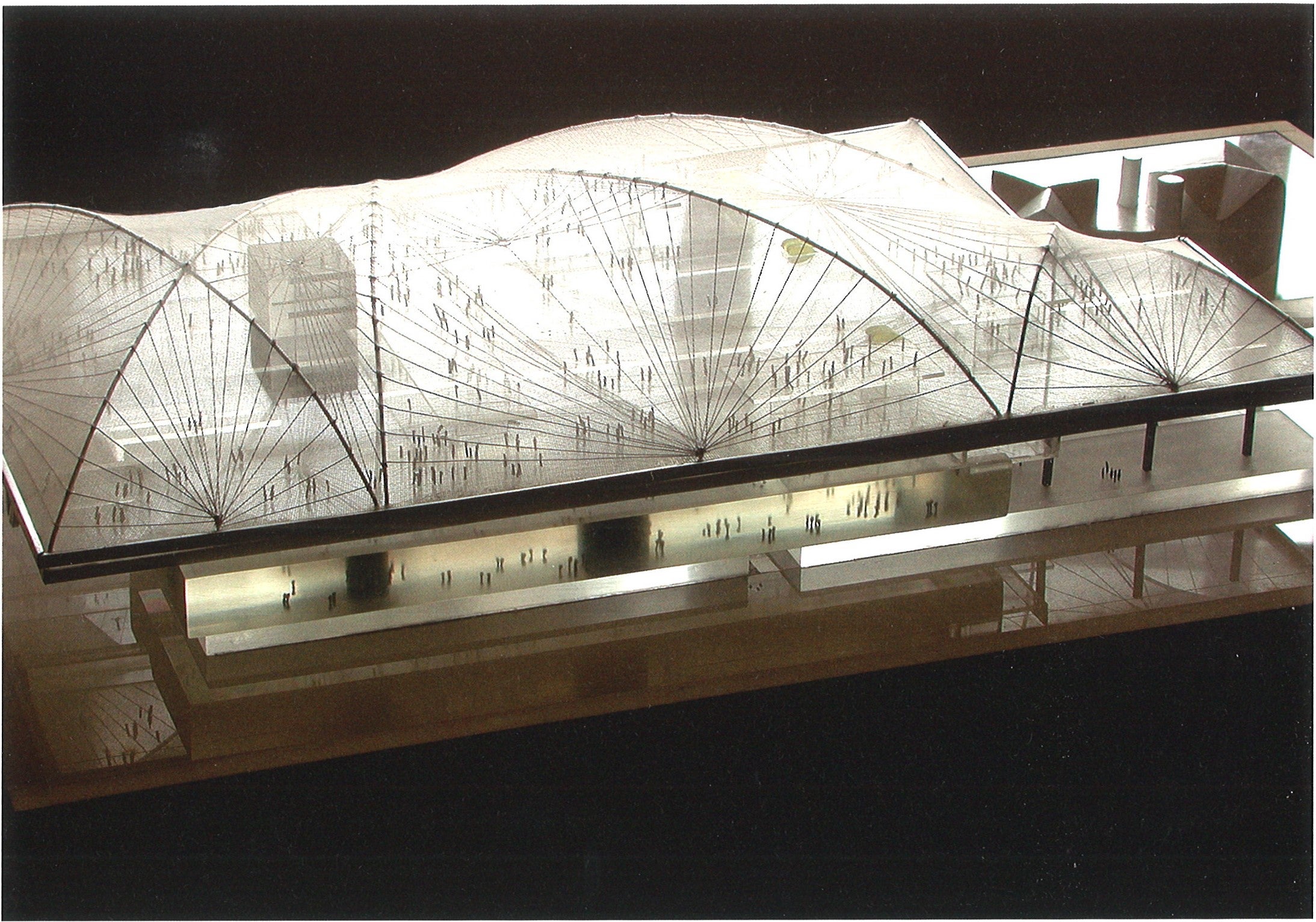
Rem Koolhaas, OMA (Office of Metropolitan Architecture)
In 2001 LACMA's board of trustees and the museum's managing director, Andrea Rich, organized a competition, commissioning five internationally recognized architects to accost what the museum admitted was "a disconnected and disorienting" campus experience. While four of the finalists adhered to the cursory of renovation and an addition to the existing structures, the iconoclastic Dutch builder Rem Koolhaas galvanized the committee with his radical proposal to demolish most of the existing campus. In its place, he planned to erect a holistic museum nether a unmarried undulating Mylar-fiber roof. He hoped that his programme to elevate the structure over an expanded plaza on a serial of physical columns would finally integrate the site by allowing people to motility freely between building, park, and city. Although this winning plan failed to garner the necessary financial support, Koolhaas'due south assertion that much of the east campus should not be preserved was a lasting legacy, as was his determination to display all of the collections on a single level. Given the great cost of seismic retrofitting and the logistical and artful deficiencies of the buildings, his plan convinced many that LACMA's best class would be to outset anew. Recent assessments have estimated the necessary repairs at more than than $300 one thousand thousand, affirming the prescience of Koolhaas's intuition.
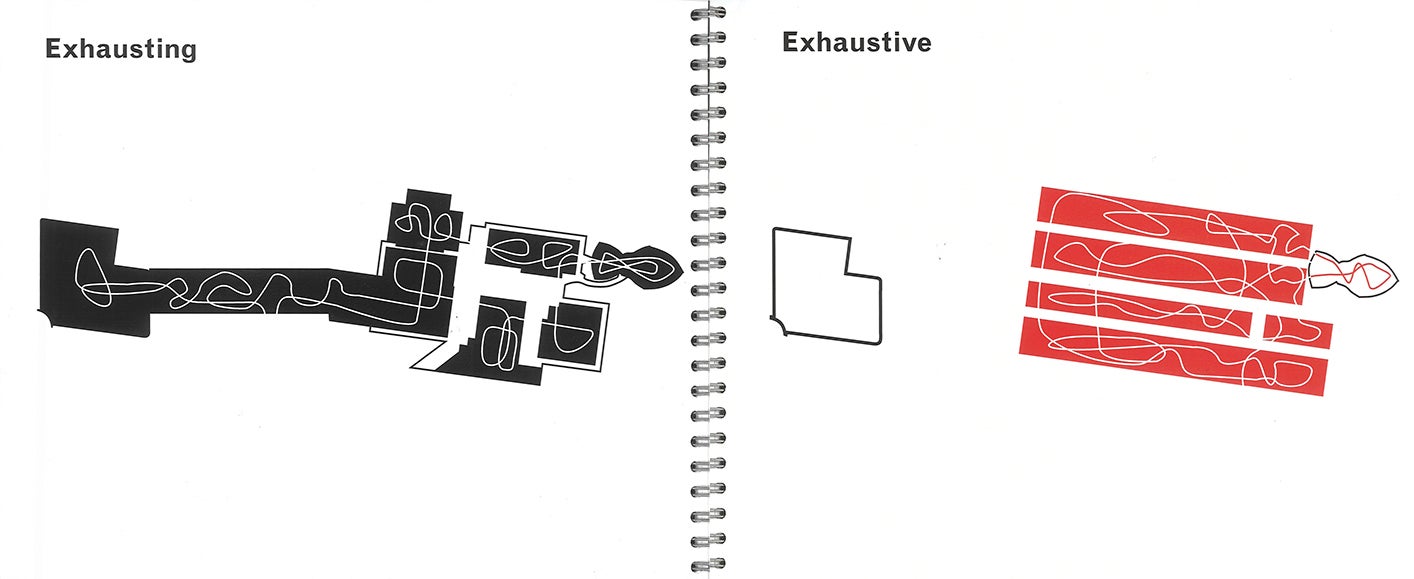
Rem Koolhaas, OMA (Office of Metropolitan Architecture)
Renzo Pianoforte's Plan
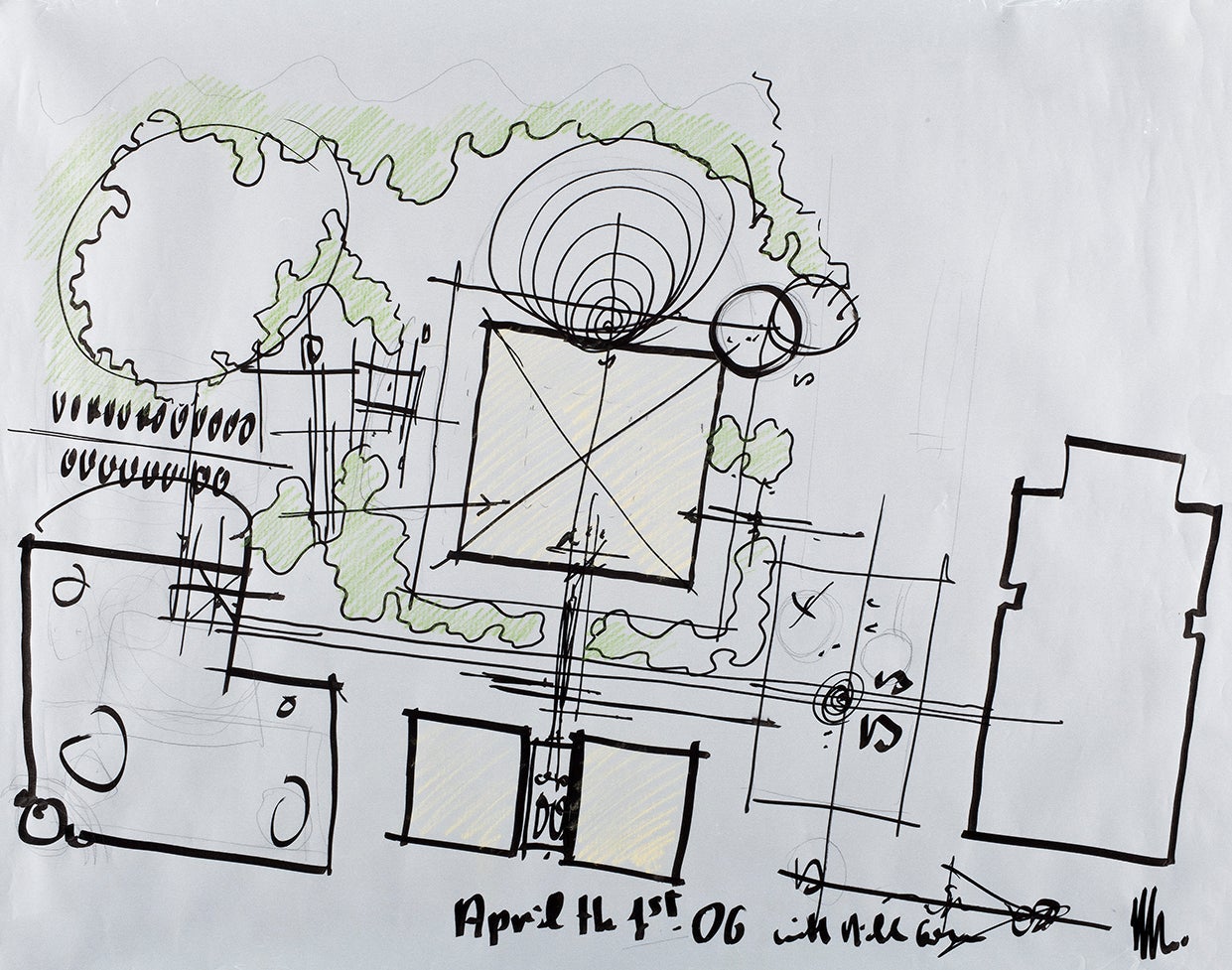
Renzo Piano, builder
After economic issues prevented the implementation of Koolhaas'southward plan, LACMA's board of trustees sought an alternative resolution to the museum's architectural challenges. Trustee Eli Broad, with the support of the other board members, originally approached the Italian architect Renzo Piano to design a single freestanding building that would be chosen the Wide Contemporary Art Museum (BCAM). Pianoforte accepted the commission under the condition that his house would "redo everything on the LACMA campus," stating, "Nosotros accept to observe a solution for the whole matter."

Piano's primary plan proposed clarifying the museum's notoriously flawed circulation pattern with a classical centrality organisation of two pedestrian paths. What he called the "sacred" axis led visitors betwixt the art galleries, flowing from LACMA Westward aslope the new structure (BCAM would be completed in 2008), through the Ahmanson Building (which would exist reconfigured to permit visitors to walk east and westward), upward to the central courtyard and, ideally, by the Tar Pits. Arguing that the "park is part of the experience," Piano saw the entire campus every bit encompassing both artistic and scientific discovery. A perpendicular "profane" axis connected the store and restaurant, moving people through a light-filled entry pavilion to an outdoor plaza. In 2006 Piano refined the plan with and so-new director Michael Govan, converting the entry into an open up-air space and ultimately designing a 2d building, the Lynda and Stewart Resnick Exhibition Pavilion, which opened in 2010. Betwixt BCAM and the Resnick Pavilion, the museum gained 100,000 square anxiety for the display of fine art, effectively doubling LACMA'due south gallery spaces and ensuring the continuation of vibrant exhibition programming during the anticipated rebuild of the east campus.
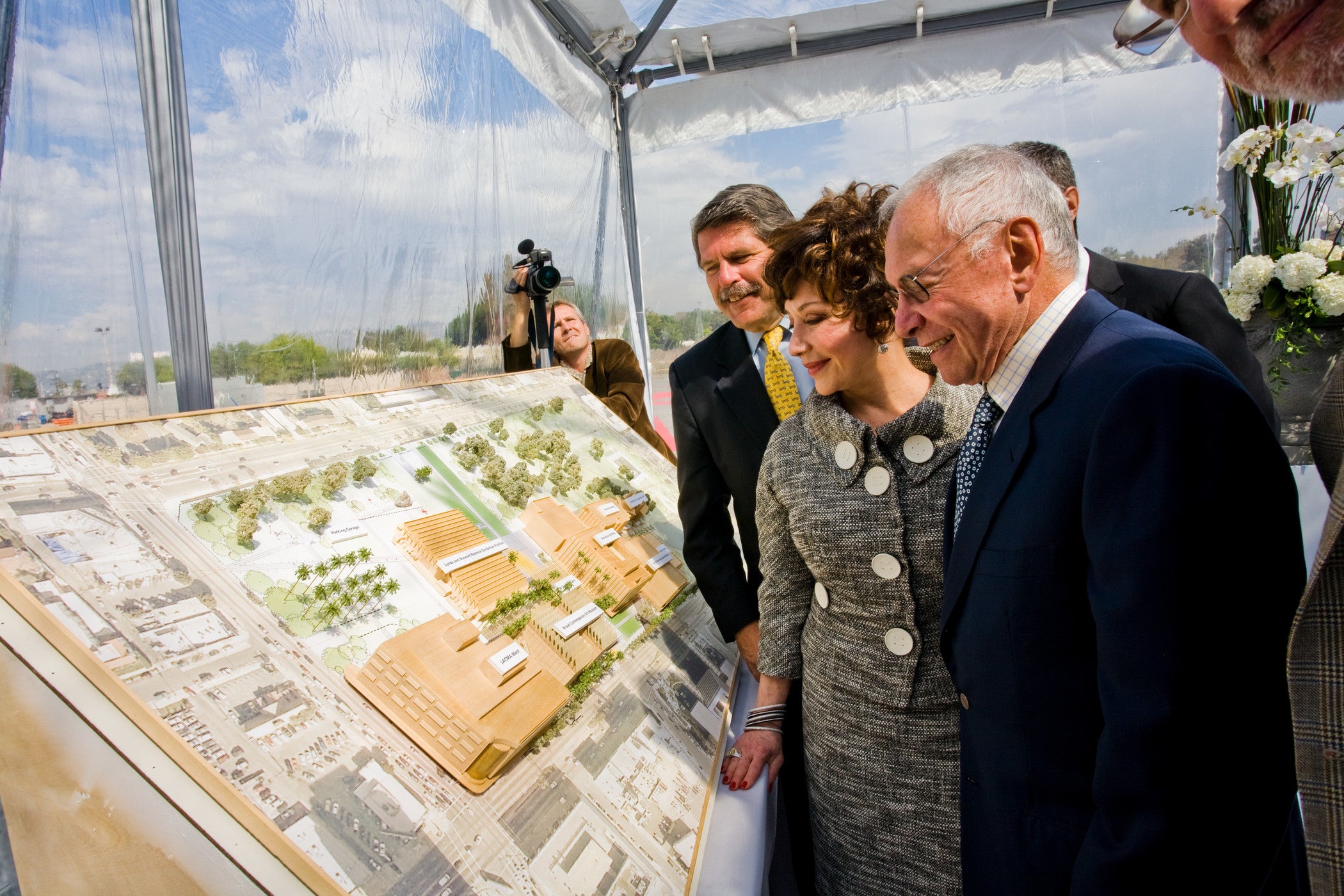
Peter Zumthor's Vision
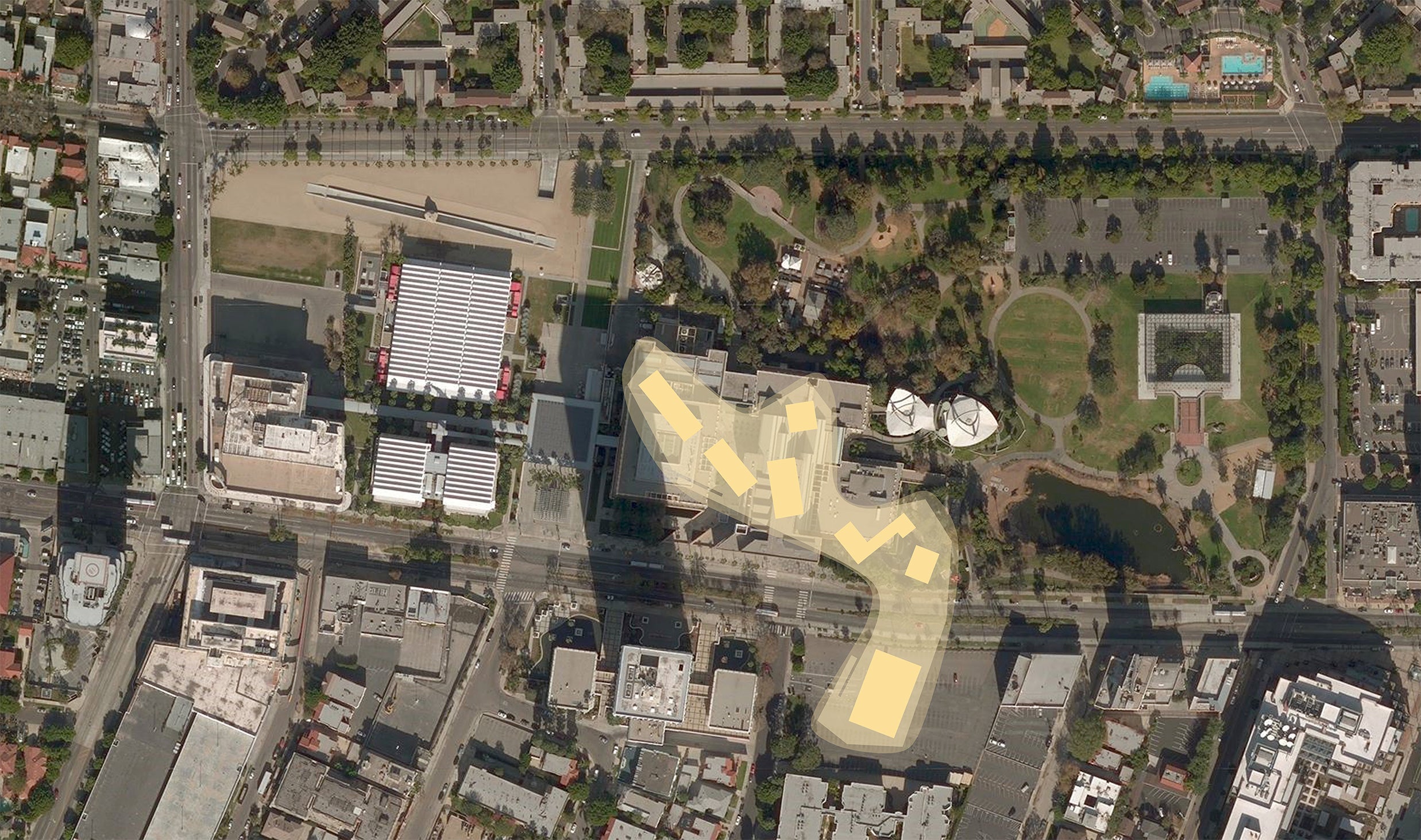
From William 50. Pereira's original scheme of the early on 1960s and Hardy Holzman Pfeiffer's attempted solutions in the '80s, to Rem Koolhaas's groundbreaking proposals of 2001 and Renzo Piano's vision of unity outlined in 2006, the history of LACMA'southward campus is a report of how financial restrictions, political compromises, and unrealized plans accept impacted the museum's architecture and the public's art-viewing experience.
Peter Zumthor's plans for the David Geffen Galleries present an opportunity to counter this history. The design ensures a future for LACMA that better serves the people of Los Angeles by facilitating richer, more than meaningful experiences with fine art, while as well fulfilling the decades-long intent to architecturally and spatially unify the museum's Wilshire campus, while at the same time creating more than public park and open space.
What does the new building project entail?
The building project entails the construction of one modern and efficient building to supplant iv aging buildings (Ahmanson, Fine art of the Americas, Bing, Hammer), too as the construction of a parking structure on Ogden Drive to replace the spaces on the existing Spaulding Artery parking lot.
Why is LACMA replacing its old buildings?
The old buildings have many serious structural issues and problems with plumbing, sewage, lack of seismic isolation and methane mitigation, defunct waterproofing, and leaks, compromising their ability to host our visitors and hold our collections.
Why can't you repair the buildings you have?
To retrofit the existing buildings would exist extremely costly while even so failing to provide the ideal setting for the collections and visitors. Almost 20 years agone, and once more in 2014, the County of Los Angeles Board of Supervisors and LACMA's Board of Trustees considered repairing the structures, and in both cases they plant the retrofitting cost prohibitive. Five years ago, the minimum estimated cost to retrofit just the visible deterioration was $246 million. Constructing new allows the museum to create both a safer building and new galleries designed to be more attainable, more functional, and more enjoyable.
Why are the galleries ane level?
The horizontal blueprint offers an egalitarian experience of LACMA'south diverse collections. Displaying all art on a single level avoids giving more than prominence to any specific culture, tradition, or era, offering visitors a multitude of perspectives on art and art history in a more accessible, inclusive way. The single-level gallery floor will also be more intuitive to navigate and easier to access, particularly for wheelchairs and strollers, and its perimeter of transparent glass will provide energizing natural light and views to the park and urban environment, with views from exterior into the galleries.
Why does the building cross Wilshire Boulevard?
The new building spans Wilshire in gild to provide 3.5 acres of new park and outdoor space for visitors in Hancock Park and the Natural History Museum's research. This public outdoor space will be dwelling to even more public sculptures and is an invaluable resource in our dumbo urban community.
How big will the new building be?
The new building totals 347,500 square feet, replacing approximately 393,000 square feet of existing buildings. There will be approximately 110,000 square feet of gallery infinite, replacing approximately 120,000 foursquare feet of gallery space. The building too includes a new theater, education spaces, three restaurant/cafes, a museum shop, and covered multipurpose result spaces. Much-improved ancillary and dorsum-of-firm facilities will back up LACMA's public programs, including two loading docks and enhanced security, facilities operations, visitor services, transit art handling, and more than.
How did you reduce the size of the new edifice from the size of the existing buildings?
The reduction in total size from that of the existing buildings is made possible by moving functions not needed within the building itself: the museum has moved offices across the street, expanding our existing office space at 5900 Wilshire, and moved art storage out of Hancock Park.
How much volition LACMA's gallery space have increased in total one time the new edifice is completed?
Past the time the new building opens, we will have expanded our total gallery infinite from approximately 130,000 in 2007 to 220,000 foursquare feet.
Does LACMA need more gallery space in its Wilshire campus?
LACMA's Board of Trustees and the County Board of Supervisors believe that later on doubling our exhibition space over the last decade, this is the appropriate size for our campus on Wilshire.
What is the budget for the new building?
Of the $750 million campaign goal, the total edifice budget is $650 one thousand thousand, which includes construction costs, soft costs, and contingencies. Of the $650 million, the structure costs ("hard costs") are estimated at $490 million. The structure cost is in line with similar projects and the cost per square pes of LACMA's Renzo Piano-designed gallery buildings, BCAM and Resnick Exhibition Pavilion (adjusted for inflation).
How is this new building being funded?
This building project is funded through an unprecedented public-private partnership where the County of Los Angeles will contribute $125 million and $625 million will come from private donations. The County will receive a 4:ane friction match for its contribution.
How much has been raised?
Over $670 million has been raised to date. The museum's trustees and leadership are actively engaged in securing the remaining corporeality.
How much is the structure cost per square foot?
The structure toll is approximately $i,400 per square foot, which is toward the depression end of the range for new museum construction (the current national market range for new museum structure in major metro areas is $ane,250 to $ane,800 per square human foot). Out of the $650 1000000 budget, the total construction toll is approximately $490 million. $490 million divided by 347,500 square anxiety is equal to $1,400 per foursquare human foot.
Is LACMA reducing space for the permanent drove?
No. The new building gives u.s. the flexibility to display collection areas for longer periods or to present permanent collections as temporary exhibitions, giving visitors opportunities to see more than art from the permanent collection in greater variety. Additionally, LACMA has always displayed works from the permanent collection in special exhibitions in BCAM and the Resnick Pavilion, and will go on to do so. The outset floor of BCAM also exhibits some of our nigh treasured permanent collection works, such as Richard Serra's Ring and Robert Irwin's Miracle Mile .
The new building has a lot of glass. Aren't museums supposed to avoid natural low-cal?
Thousands of works in our collection (sculpture, tiles, ceramics, and more) can be safely displayed in natural light, and are in fact wonderful to view in that setting. The new edifice volition have a range of exhibition spaces, from galleries with natural lite to galleries with controlled artificial lighting. The majority of galleries in the new building are designed to be able to display light-sensitive works. Natural light and views to the park along the perimeter of the building also will reduce fatigue in our visitors.
Why are the gallery walls concrete?
Concrete was chosen to give the building a sublime aesthetic character and beautiful sense of gravitas. Concrete walls have been utilized successfully in other museums like the Kimbell, the Guggenheim, and Kunsthaus Bregenz. Not ane artist whose piece of work was displayed at Bregenz has ever covered that museum'due south walls with sheetrock. Additionally, many objects and antiquities in our drove originated in buildings or other settings built from stone, so it is particularly plumbing fixtures to display them in physical-walled galleries.
Will Urban Light exist moved?
Urban Light will stay in place and visitors will go along to be able to enjoy the artwork.
Is the construction on the former May Company building part of LACMA'southward projection?
No. The structure on the former May Visitor building is the new Academy Museum of Motion Pictures existence congenital past the Academy of Motility Movie Arts and Sciences. The globe-shaped structure that is visible to the west of LACMA houses the Academy Museum's theater.
Where would LACMA expand in the futurity?
LACMA is pursuing the next phase of its expansion through boosted museum spaces across L.A. County, enhancing the accessibility of our collections and bringing art and art didactics to communities throughout our vast county. We already have ongoing exhibition, education, and public programming at Charles White Uncomplicated Schoolhouse in MacArthur Park, collaborations with the Vincent Price Fine art Museum at East Los Angeles College in Monterey Park, and an additional museum currently being planned in South L.A.
What is the timeline for the new building?
Structure began in 2020. The building volition be completed by the end of 2023 and open to the public in 2024.
Source: https://www.lacma.org/support/building-lacma
ارسال یک نظر for "Art Object Has a Specific Relationship With the Culture"